#ASEAN CAFE TIME!!
Explore tagged Tumblr posts
Text
WELCOME TO THE ASEAN Cafe and Bakery GRAND OPENING MENU!
These are one of a kind ⛄️❄️Exclusive to Winter Pastries 🎄❄️ made by yours truly (Indonesia @ask-hws-indonesia, Malaysia, Philippines @ask-the-pearloftheorient, Singapore @ask-hws-singapore , Vietnam and Me!)
All these delicious treats will be available starting from today till February 28th 2025! Get these special items 50% off for this week and next week only!
Prices are as follows!
Cakes | 5.99 USD / 204 THB / 350 PHP
Cookies | 2.99 / 102 THB / 204 PHP
Drinks (Anything you wish for, we provide!) | 0.75 USD / 25 THB / 43 PHP

(Graphic design by mun)
(Disclaimer: does not cost real money)
#hws ask blog#hws thailand#hetalia#hetalia rp blog#feel free to interact#hetalia ask blog#interaction#ASEAN CAFE TIME!!#do the 50% off math yourself -ooc
8 notes
·
View notes
Text
Moka Pots Market: Global Size, Share, Trends, Application Analysis and Growth by Forecast to 2031
The latest “ Moka Pots Market Forecast | Share and Size - 2031” report by The Insight Partners offers a detailed analysis of prime factors that impact the market growth such as key market players, current market developments, and pivotal trends. The report includes an in-depth study of key determinants of the global market including drivers, challenges, restraints, and upcoming opportunities.
This market report is ideal for businesses opting to enter or excel in the Moka Pots market. This strategic market forecast not only makes businesses aware of present market scenarios but also presents future market forecasts. These insights profoundly cover Moka Pots market size, share, growth, and projected revenue in the forecast duration.
The Moka Pots market report encompasses driving factors of the market coupled with prime obstacles and restraining factors that hamper the Moka Pots market growth. The report helps existing manufacturers and entry-level companies devise strategies to battle challenges and leverage lucrative opportunities to gain a foothold in the global market.
How is the Moka Pots Market Report Beneficial for Your Business?
Figure out the Moka Pots market dynamics altogether | 2031
Inspect and scrutinize the competitive scenario and the future Moka Pots market landscape with the help of different strictures including Porter's five forces.
Understand the impact of different government regulations throughout the global Moka Pots market and evaluate the market condition in the tough time.
Consider the portfolios of the protruding players functional in the market in consort with the thorough study of their products/services.
Have a compact idea of the highest revenue-generating segment with the help of a thorough Moka Pots market analysis by our seasoned research experts.
A cost-effective way to gain valuable insights into the Moka Pots market without the need to host an independent team of researchers at their own cost.
Moka Pots Market diagrams, pie charts, regional market share maps, inventory network examination, and import/trade subtleties help you pitch investors.
The Moka Pots market report offers an in-depth analysis of the various prime market players that are active in the market. Moreover, it provides their thorough financial analysis, business strategies, SWOT profile, business overview, and recently launched products & services. In addition, the report offers recent market developments such as market expansion, mergers & acquisitions, and partnerships & collaborations. The prime market players observed in the report are Companies Alessi,Alpha Coffee,Bialetti,Bison International,Cafe Jei,Cuisinox,De'longhi,Grosche,Instacuppa,Something's Brewing
On the Basis of Type this market is categorized further into-
Electric Moka Pots
Stovetop Moka Pots
Others.
On the Basis of Distribution Channel this market is categorized further into-
Supermarkets and Hypermarkets
Specialty Stores
Online Retail
Others
The report offers an in-depth study of every segment, which helps market players and stakeholders understand the fastest-growing segments with maximum Moka Pots market share and highest-grossing segments in the market.
The Moka Pots market is analyzed across the globe and highlights several factors that affect the performance of the market across the key regions –
North America (U.S., Canada, Mexico)
Europe (U.K., France, Germany, Spain, Italy, Central & Eastern Europe, CIS)
Asia Pacific (China, Japan, South Korea, ASEAN, India, Rest of Asia Pacific)
Latin America (Brazil, Rest of Latin America)
The Middle East and Africa (Turkey, GCC, Rest of the Middle East and Africa)
Rest of the World
The Moka Pots market research offers revenue forecasts for every year coupled with sales growth of the market. The forecasts are provided by skilled analysts and after an in-depth analysis of the Moka Pots market trends. These forecasts are essential for gaining investment insights into the prospects of any industry.
Author’s Bio:
Akash Khilare
Senior Market Research Expert at The Insight Partners
0 notes
Photo

515sunnyday: [카페 아세안 X 써니 데이] ��� 오는 11월 15일 금요일, 서울 시청광장에서 운영될 '카페 아세안'에 소녀시대 써니가 함께합니다☀ ⠀ 오전 11시부터 11시 50분까지, 1일 바리스타 써니와 함께하는 아세안 커피 타임☕ ⠀ 한·아세안 특별정상회의D-10을 맞아 더욱 특별하게 진행되는 이번 행사�� 많은 분들의 관심 부탁드리겠습니다💕 ⠀ ※ 현장 상황에 따라 행사 운영시간 변동 가능 ⠀ #CAFEASEAN #2019한아세안특별정상회의 #제1차한메콩정상회의 #한메콩 #한아세안 #아세안커피 #커피트럭 #스페셜커피 #커피 #카페 #서울 #서울시청 #서울광장 #시청광장 #써니 #소녀시대#sunny #girlsgeneration
https://instagram.com/p/B4t2H4HD5eo/ https://scontent-iad3-1.cdninstagram.com/vp/1774275fde710d4086a7e32d1e1c19bd/5E670C1E/t51.2885-15/e35/75296742_580981622642751_4185988716878288104_n.jpg?_nc_ht=scontent-iad3-1.cdninstagram.com&_nc_cat=1&se=8&ig_cache_key=MjE3NDYzMjIzMDg4NTc1ODg4OA%3D%3D.2
[TRANS] [Cafe Asean X Sunny Day] ⠀ On Friday, November 15, SNSD Sunny will join for ‘Cafe Asean’ which will operate around the Seoul City Hall Plaza ☀ ⠀ From 11:00 to 11:50 AM, Asean coffee time with 1 day barista Sunny☕ https://t.co/ffpywFoRvr
— 💗 Stella 💗 (@SonexStella) November 11, 2019
1 note
·
View note
Photo

Consolidated Schedule of Lessons and Events
Click on instructor names, lesson titles and locations to be redirected to corresponding information
6 July, Saturday
9:00 AM to 12:00 PM Lesson 01 with David Liew Digital Illustration – Apple & the Art of Urban Sketching S P Jain School of Global Management
12:00 to 2:30 PM Event 01 Welcome Reception and Registration S P Jain School of Global Management
3:00 to 6:00 PM Lesson 02 with Patrick Ng Secrets to Good Composition S P Jain School of Global Management
7 July, Sunday
9:00 AM to 12:00 PM Lesson 03 with Ken Lee A Different Perspective Hort Park
1:00 to 4:00 PM Lesson 04 with Tia Boon Sim Great Wall of Sketches - PANO! Bury Road
4:00 to 7:00 PM Lesson 05 with Favian Ee Measuring Up! Gillman Barracks
13 July, Saturday
9:00 AM to 12:00 PM Lesson 06 with Jenny Sim KISS Keep It Simple Sketcha! Hort Park
1:00 to 4:00 PM Lesson 07 with Priya Subramaniam Capturing the Mood in Gouache Hort Park
4:00 to 7:00 PM Lesson 08 with James Lim The Makan Sketcha – Food & Cafe Sketching Gillman Barracks
14 July, Sunday
9:00 AM to 12:00 PM Lesson 09 with Francis Theo Fountain Pen Inkspiration Gillman Barracks
12:00 to 3:00 PM Lesson 10 with Pocholo Estremos Creating Atmosphere in Watercolours Labrador Nature Reserve
2:00 to 5:00 PM Activity 01 with all participants and visitors 10x10 Sketchwalk and Artist Demos Labrador Nature Reserve and Keppel Bay
6:00 to 9:00 PM Event 02 with all instructors, participants and visitors Closing Dinner with Show & Share S P Jain School of Global Management
Overview of Locations

USK10x10SG this year takes us into the beautiful greenery of southwestern Singapore, in sections of the Southern Ridges and the coast.
We are grateful to S P Jain School of Global Management for hosting us in their Singapore campus; workshops will be conducted there and in Hort Park, Labrador Nature Reserve, and Gillman Barracks.
Urban Sketchers 10x10 2019 - Singapore Edition
This event aims to debut and develop long-term Urban Sketchers courses by instructors in Singapore, following up from the ASEAN edition hosted here in 2017. We invite sketchers from around the world to join ten on-location classes, with facilitators from Singapore, to learn and reinforce the core value of urban sketching; sketch the world, one drawing at a time.
The USk10x10SG course spans ten classes across the spectrum of abilities, mediums and modes of expression in visual art.
We aim to help participants achieve these goals when classes conclude, and equip them to:
show stories of USk10x10 host city, one drawing at a time;
improve drawing skills; learn how to select, frame and design visual stories on a page;
learn how writing and drawing can work together to communicate more to audiences;
experience the advantages of group learning and seeing the many paths to success.
You can sign up from now until 21 June 2019, and find out more about the lessons on offer and the instructors running them.
Keep up with us on the Facebook event discussion wall, and do indicate that you're going. For all enquiries related to this event, please write to [email protected].
1 note
·
View note
Text
"Being there for Thailand’s small businesses"
Around 1.3 million Thai small businesses have been affected by the impact of COVID-19—from clothes manufacturer Chu Su Mo in Chiang Mai, to coffee shops like Hidden Tree Garden in Samut Songkhram. These businesses are often at the heart of their communities, supporting local jobs and services. They’re also critical to the Thai economy as a whole, accounting for more than 90 percent of all businesses in the country. As Thailand rebuilds from the pandemic, we’re focused on supporting its business owners through the economic recovery.
Digital skills training in a time of need
Today, at our virtual Google for Thailand event, we launched Saphan Digital: a new Grow with Google program to help small businesses and other organisations learn digital skills and make the most of online opportunities. (In Thai, “Saphan” means bridge, and this program is designed to help bridge the digital gap between Thais who know how to use the internet and those that can’t.)
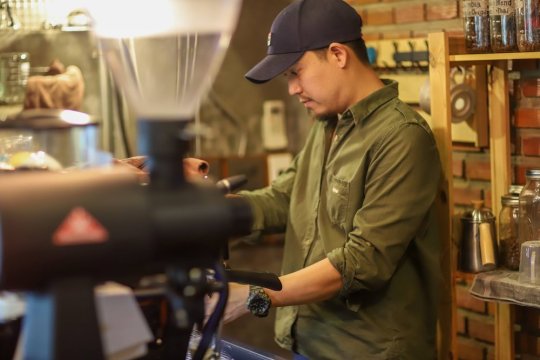
While the owners of Hidden Tree Cafe had to close during COVID-19, they kept posting photos of their drinks and desserts on Google My Business — meaning demand was strong as soon as they reopened.
Throughout the pandemic, we’ve seen the importance of the internet in enabling businesses to continue operating—even if it’s something simple like letting customers know they’re still open, or offering information about online shopping and delivery options. Saphan Digital will equip business owners, NGOs and workers to use digital tools and set up a basic online presence, as well as provide online training courses in business and digital skills—covering topics like e-commerce and creating a digital storefront. After completing the training, people taking part will be able to “pair” with a small business or NGO to apply what they’ve learned.
The program is a partnership with Thailand’s Ministry of Commerce and backed by local and international businesses, with corporate partners like LnwShop and BentoWeb providing tools and mentoring.

Saphan is part of a bigger effort to ensure Thais can use technology with confidence—one we’re expanding to support the country’s coronavirus response.
Skills and education beyond COVID-19
Existing Google initiatives like Academy Bangkok are now offering online courses for graduates and experienced professionals, while The Asia Foundation’s Go Digital ASEAN program—supported by Google.org—is helping Thai micro-entrepreneurs in 20 provinces who wouldn’t otherwise have access to digital training. For students and teachers, we announced today that we’ll be integrating G Suite for Education into Thailand’s Digital Education Excellence Platform, meaning that all Thai public schools will be able to access Google’s education tools free of charge.
Our mission in Thailand is to “leave no Thai behind,” as we work with our partners to build a stronger, more inclusive digital economy. With these new initiatives, we’re reaffirming that commitment to this amazing country’s future.
Source : The Official Google Blog via Source information
0 notes
Text
Day 1 Part 2: Exploration No. 01
After going through the unexpected happy incident of stay upgrade, I was finally able to walk the streets of Bangkok without worrying about major things. The only goal was: 𝘏𝘜𝘞𝘈𝘎 𝘔𝘈𝘓𝘐𝘎𝘈𝘞.
As a city gorl, 𝘥𝘪 𝘢𝘬𝘰 𝘮𝘢𝘴𝘺𝘢𝘥𝘰 𝘯𝘢𝘩𝘪𝘳𝘢𝘱𝘢𝘯 𝘪𝘧𝘪𝘨𝘶𝘳𝘦𝘰𝘶𝘵 𝘢𝘯𝘨 𝘬𝘢𝘯𝘪𝘭𝘢𝘯𝘨 commute system. I relied on google maps on what routes to take. There was a train and some bus stations near us so it’s already pretty convenient. Their public commute system was organized so it’s not bad at all.
My agenda for my only solo day was simple – go to their Kilometer Zero marker, visit the nearby galleries, have a quiet time near a scenic river, and get post cards. So, after a 15-minute walk and another 15-minute waiting time, I boarded bus number 9.
The only problem I had was that their signs were all in Thai! And even in google, the places were mostly in their language. I needed to keep showing their ticket person (basically 𝘬𝘶𝘯𝘥𝘰𝘬𝘵𝘰𝘳) my destination through my phone so they would know and let me know when I have to get off. Anyway, you can track yourself through the google maps app so it was already convenient. It was amusing and really commendable.
The 0 𝙆𝙞𝙡𝙤𝙢𝙚𝙩𝙚𝙧 𝙈𝙖𝙧𝙠𝙚𝙧 is around their 𝘿𝙚𝙢𝙤𝙘𝙧𝙖𝙘𝙮 𝙈𝙤𝙣𝙪𝙢𝙚𝙣𝙩 which is at Pra Nakhon district. There are 2 galleries; Contemporary Art Gallery and The Queen’s Gallery, and an interactive exhibit; Rattanakosin Exhibition Hall, around the area as well.


After checking out their 0km marker (which is poorly kept, hehe), I ate my lunch at the most authentic place to – at Mcdonald’s! HAHAHA I know, okay!! But I had to get it out of the way cos I’m already there and I wanted to check out the fastfood menu. Sorry to disappoint!


Walking back to where I got off, the first stop was the 𝘾𝙤𝙣𝙩𝙚𝙢𝙥𝙤𝙧𝙖𝙧𝙮 𝘼𝙧𝙩 𝙂𝙖𝙡𝙡𝙚𝙧𝙮! There was no entrance fee but you have to register. (Every door and desk you would approach have a hand sanitizer container free for everyone, even in buses and trains, so it’s somewhat reassuring to go around the city.) There was a fresh exhibit at the ground floor but they direct you to 3rd floor first, where the ASEAN Exhibit was ongoing.
I had fun going around the ASEAN exhibit since there’s no other visitors but 2 kids playing at the designated area. I went around and checked out the interactive displays (some details about the Philippines were inaccurate! Haha) and then the guard respectfully approached me to tell me he’d gladly take my photo if I need him to. I did give him my phone for a photo. It was nice how accommodating he was.

The interior of the gallery was interesting so I decided to take the stairs going down. I already thought of my artist friends holding their own exhibits there. Would be great if I could come with them next time, they’d sure appreciate it too.
There were more people at the ground floor exhibit which I later on found out to be an ongoing installation which would open for public the next day; Conflux, a five-artist group exhibit. The organizers let me go around, though. 𝙏𝙝𝙚𝙧𝙚 𝙄 𝙢𝙚𝙩 3 𝙖𝙧𝙩𝙞𝙨𝙩𝙨 𝙬𝙝𝙤 𝙬𝙚𝙧𝙚 𝙞𝙣𝙨𝙩𝙖𝙡𝙡𝙞𝙣𝙜 𝙩𝙝𝙚𝙞𝙧 𝙖𝙧𝙩𝙬𝙤𝙧𝙠��!



I met 𝙂𝙪𝙢𝙨𝙖𝙠 𝘼𝙩𝙞𝙥𝙞𝙗𝙤𝙤𝙣𝙨𝙞𝙣 who painted gorgeous abstract pieces, 𝙏𝙝𝙖𝙬𝙚𝙚 𝙏𝙪𝙣𝙜𝙢𝙤𝙣𝙜𝙠𝙤𝙡𝙬𝙖𝙣𝙞𝙩 who painted realistic industrial remains, and 𝙉𝙪𝙩𝙨𝙪𝙧𝙚𝙚 𝙏𝙚𝙘𝙝𝙬𝙞𝙧𝙞𝙮𝙖𝙩𝙖𝙬𝙚𝙚𝙨𝙞𝙣 who painted details portraits of popular skin care activities. Thawee approached me and asked me if I’m there for the exhibit and I told him I was passing by and took my chance to explore the enticing installations. He was pleased to hear it so he introduced himself to me then the other 2 artists to me. They told me about the opening the following day. They invited me and we had a few more minutes of conversation before they left me to go around by myself.
It was already past 3pm when I got out of the Contemporary Art Gallery so I wasn’t able to catch the last interactive exhibit at Rattanakosin Exhibition Hall so I went to walk around for a while instead. I passed by the 𝙍𝙤𝙮𝙖𝙡 𝙋𝙖𝙫𝙞𝙡𝙞𝙤𝙣 𝙈𝙖𝙝𝙖𝙟𝙚𝙩𝙨𝙖𝙙𝙖𝙗𝙖𝙙𝙞𝙣 and 𝙆𝙞𝙣𝙜 𝙍𝙖𝙢𝙖 𝙩𝙝𝙚 𝙄𝙄𝙄’s statue.
I stopped by the 𝙋𝙝𝙖𝙣𝙛𝙖 𝙗𝙧𝙞𝙙𝙜𝙚 and just absorbed the stillness around. It was shady around the area so it was a good afternoon quiet time.

The Queen’s Gallery was closed but I wanted to continue my peaceful exploration so I continued walking the 𝙋𝙝𝙧𝙖 𝙎𝙪𝙢𝙚𝙣 𝙧𝙤𝙖𝙙. I passed by several cafes and quaint bars and stopped by Passport Bookshop to get postcards.
I found 𝙋𝙖𝙨𝙨𝙥𝙤𝙧𝙩 𝘽𝙤𝙤𝙠𝙨𝙝𝙤𝙥 to be one of my favorite stops the entire Bangkok trip because of the place itself. It was a small bookshop and café with lots of postcards from many people who once visited the shop. The postcards were sent from different places and I plan to send them one once this ECQ ends. There were so many interesting books with really creative covers but I didn’t get any since I’d be visiting more bookshops with the boyfriend in the coming days.

After the bookshop, I passed by a stationary shop and waited for the bus in front of it as the owner suggested. I was able to catch a non-air conditioned bus going back and got stuck in traffic for quite a while. I bought some food and fruits on my walk back to the accommodation.
𝘞𝘦𝘸! 𝘕𝘢𝘱𝘢𝘨𝘰𝘥 𝘥𝘪𝘯 𝘢𝘬𝘰 𝘮𝘢𝘨𝘬𝘸𝘦𝘯𝘵𝘰! Haha And that is how my only solo day in Bangkok went. It was definitely one for the books. If you’re traveling to another country with someone else, try to ask for a solo day and see what amazing stories you might have throughout.
𝙄𝙩𝙞𝙣𝙚𝙧𝙖𝙧𝙮:
- Rang Nam Alley, Ratchathewi District (where accoms is) - Democracy Monument - The 0 Kilometer markter - Mcdo (lol) - Contemporary Art Gallery - Rattanakosin Exhibition Hall (Di ako umabot lol) - Phanfa Bridge - The Queen’s Gallery (closed on Wednesdays! >:c) - Passport Bookshop
0 notes
Photo

Deviation
“I really don’t recognise that this is siam square one in the picture”
“Me too, these green has cover it all up”
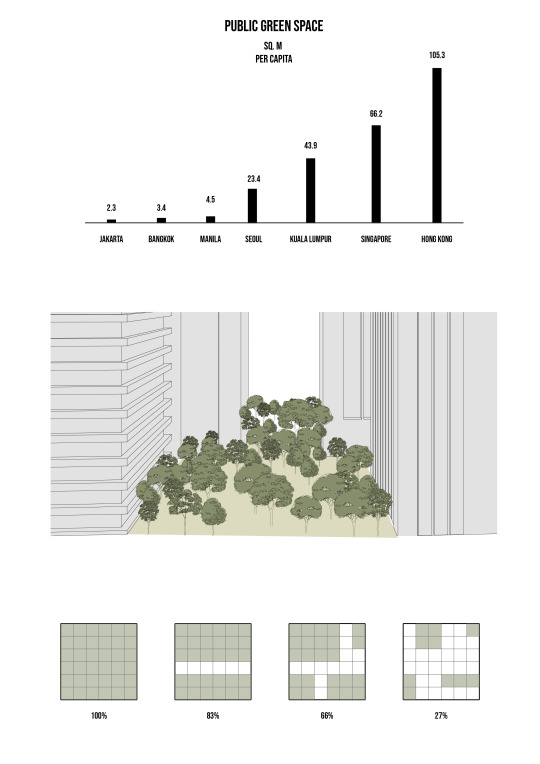
// full resolution
Did you know that Bangkok is one of the cities that has the least green space per capita in ASEAN? We have around 3 sq.m per capita, very little when compared to Singapore with 66 sq.m or Hong Kong with 105 sq.m. So we are planning to build more green space in Bangkok to improve environmental issues and global standards.

// full resolution
What is the first park you think of in Bangkok? Lumpini park? Suan Rodfai? These parks are huge, it takes more than 300 rai to build these kinds of parks in Bangkok like we have to wipe out the whole neighborhood of Baan Krua, or Nangleong, or even Mega Bangna.

// full resolution
Or the other option is to build it more, but smaller which I think it makes more sense. So the scenario is to have more gardens but elevated in the whole city of Bangkok, giving a sense that there is a large continuous landscape, barely visible in the distance

// full resolution
Here is the conceptual diagram of how the elevated park should be placed. As the place is small, we will use the perspective to make a couple of smaller gardens look continuously and bigger just like the English garden does, but where to start? Actually starting along the BTS line, as a collective privileged transit trajectory can give the possibility of studying analytically a shared point of view. The garden will be applied a lot of perspective trick to make it looks bigger. for example the inverse perspective, and mirror to reflect more green space
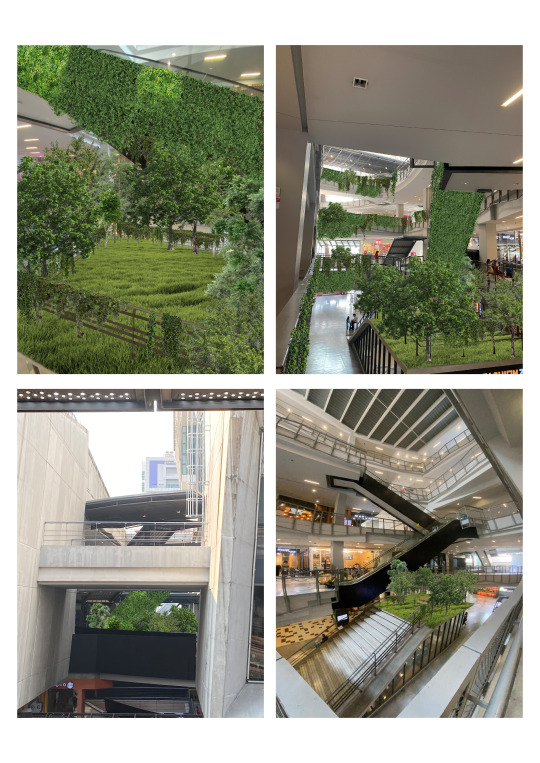
// full resolution for all images
This is the example fictional scenario in siam square one. You can see that the near perspective looks quite convincing, and the view from the BTS looks like we have a little park inside siam square one. But from 5 and 10-meter distance, you can see clearly that it doesn’t as big as it tries to be in the first and last image.
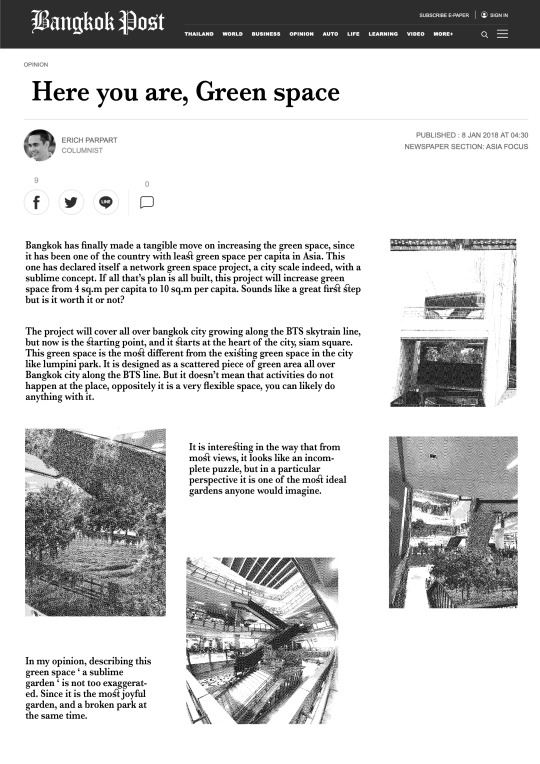
// full resolution

// full resolution

// full resolution

These are a few possible ways of how people might react to this future scenario. People might enjoy the view in the park and the place will become viral on Instagram, or people can disagree with the project. The media platform like the Bangkok post might try to evoke the question like, is it worth or not for these park concept. Or websites like Wong Nai or others can suggest and promote this place as a place to go and take a nice picture.

// full resolution
The Short Story
“Chertam, are you free this evening?” “Yes, why?” “I am running out of my foundation, I need a new one. let’s go to siam square” “Sure I will, i need new eye liner too”
After two of them get everything they need, they decide to grab a drink at one of the coffee shop in siam square one. While they were talking and enjoying coffee, Chertam has noticed a little bit of green in this mall.
“Hey look at that, that's the new park in siam square” “It’s pretty small, is it?” “Yes it looks really small and very strange” “Can we go inside?”
“I think it’s free of charge, we can go inside” “It’s amazing being inside here” “I feel you” “This corner is nice too, do you want to take a picture?” “Yes!”
They took sometimes to take picture for each other in the small garden. While others are, too, taking pictures.
“I really don’t recognise that this is siam square one in the picture” “Me too, these green has cover it all up” “But what is this place for actually?” “Like a small park maybe?”
“But i wouldn’t hang out here to be honest. Will you” “Hm i don’t know” “Like if you can choose, chilling here, or a cafe nearby, what will you choose?” “Cafe absolutely” “Right? everyone here is just taking photos and left” “Or that is the purpose?”
Then couple of people walked inside the park with a picnic basket. So two of them rushing out of the park because it is not big enough to fit so many people at the same time. If this park become popular, Chertam guesses they have to get in line maybe?
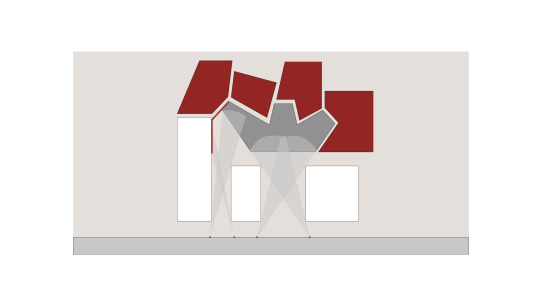
// full resolution
And lastly, with the political and economic approach, because it’s a big project all over Bangkok, the government might not have enough money to do it. so this project will be invested and maintained by the developer and people can enter free of charge, but the developer can have an advantage in other aspects instead, for example, the FAR bonus. The construction of perfect perspectives might actually require the modification of the built environment, adding volumes to frame the vision, which would give an opportunity for densification and real estate speculation. As we build more green spaces, maybe we have to build more buildings.
0 notes
Text
My ASEAN Explorer Camp in Jakarta, Indonesia Experience:
I made new friends, explored a new country, learned new lessons, and I’m forever grateful for it.


As I was still digesting everything that happened last 16-18th of July, one thing crossed my mind- My ASEAN Explorer Camp in Jakarta, Indonesia is Amazing! It was A(plus)-kay!!
Let’s talk about it one by one, piece by piece, so grab a drink and relax. Let me start of the day before my flight, It was a very busy day for me since I have a lot of agenda. I have my accounting class from 8:00-2:00PM then after that, our whole clan will celebrate the wedding anniversary of our beloved great grandfather and great grandmother, then I have to attend my best friend’s debut at 7:00PM onwards, then went home at 11:00 PM to pack my baggage and went to the airport at 2:00 in the midnight for my auntie’s departure, and so is my flight. I know, I get it, I’m so busy? Yeah, but I enjoyed every single agenda that I have before my flight.
It was my first solo flight and in contrary, I was not afraid. I enjoyed it. I love the view in the airport and the fluffy clouds.It is my kind of aesthetic.

Some people thought I was Indonesian and talked to me in their native language. I agree, Indonesian looks like a Filipino. Jakarta looks like Manila, too! I From that moment, I feel like I’m home. A home far away from home. I’m used to this, when I am in Malaysia for a stop over, Airport personnels thought I’m Malaysian and when me and my family went to Hong Kong, they thought I am from Hong Kong and talked to me in Cantonese. Am I a representative of another country, as well? Haha.
The flight may be long, but it was worth it, especially when we finally arrived at Jakarta. Thank you Ms. PA for waiting for us and accompanying us to the hotel.
When we arrived at the hotel, I finally saw Prisca and Ate Hershel. We were so excited and hugged each other. After that, we went for an ample rest. Not to mention that the hotel is instagram worthy, especially the walls inside the rooms, and so, me and my roommate, Ate Amae went for an instagram photo during our last stay in the hotel.

Add more, the sky garden which made my city heart more happy.

We went outside to eat dinner, we tried local Indonesian food. I hate spicy food, but it tastes good!

Second day:This the highlight, we meet our fellow Indonesian Field Reporters, have some time to know each other and conducted an interview with them. I teamed up with the very smart and pretty, Niswah, together with Ms. Pham to supervise us. Thank you for your patience, Ms. Pham. The interview is fun and challenging. We got rejected and accepted by some businesses in Indonesia, but the experience is worth it. We learned how to approach people, interview them face to face and even learn from their personal experiences. When one business closed its door, expect that another door will be opened, better and bigger.
We conducted 3 interviews around Jakarta. The first interview is about a family business whom the late Father is the founder. The business is still on its operations until today, despite the death of the founder. It just shows that a business can continue in its operation no matter what. As of today, the business is managed by the Late Founder’s children.
The second interview is a Cafe. The cafe is inspiring to be international, and as a matter of fact, they have an employee who traveled all the way to Australia to study.
The third interview focuses on the steps and struggles of how he became an HR in his company. He said that it was not easy and it is indeed full of struggles, but as you analyze it, it is his struggles that made him who he is today.
The interview is challenging and fun despite of the sunny weather that day, but it broadened my idea on how business operates and how people work in a company.
(Also see: https://www.instagram.com/p/BXNeJt3jYqI/?taken-by=clarysjourney )
After the interview, we went to ASEAN Foundation. We met the people behind it and learned from their projects. We also received our certificates. This talk encouraged me to broaden my horizon and empower the whole ASEAN community.

After the said talk, we went inside the ASEAN Foundation room again to report about what happened during our interviews. This is my favorite part, since I learned from other experiences, if I can vote for every team, I will.

After that, we went to Grand Indonesia Shopping centre for dinner. This is also a time where we talked about each and every one’s interest.

The announcement of the winner for reporting our experiences finally came, Thank you everyone! Hardworks really pay off. We did it!!

Though it’s hard to say goodbye, we don’t have any choice, but to say it. Our fellow Field Reporters from Jakarta has to leave. We enjoyed their presence and hospitality.

After saying goodbye to our fellow Field Reporters, we went to another mall and just explored it.

Third day: This is the last and heartbreaking day of the camp. Last breakfast together. Last face to face talks. Last day. It’s time to leave.
It was a heartfelt opportunity to meet Mrs. Ingrid from Lestari Sayang Anak. I might not be able to finish her whole story, but right from the start, I saw her heart for her orphanage. Mrs. Ingrid may not have any child, but she has a family fueled by love, compassion, and goodness.

Me and the Cambodian guys, Songg, Piseth, and Nara went straight to the airport after the breakfast. Thank you for talking in your native language when I was with you guys, I understand every word, but thank you.
It’s time to go back to my country, but the lessons and memories will forever bloom. I didn’t not say goodbye, but instead, see you soon!
Jakarta. 3 days. 6 countries. 1 Amazing Team. Countless smiles.
Being a Field Reporter helped me to explore, not only in the sense of setting foot to another country, but on relationships, career, and life.
In another country: You need to go out of your own land to see the world or one side of the world. One side of another country may look like home, and the other one may not look like one, but enjoy it. It’s once in a lifetime opportunity. Try their local foods, eventhough it’s spicy. Grab a little or more. Be friends with locals. Explore the place.

On relationships: Be friendly as you can, though it’s hard, open yourself to others. Let them know you. Let them learn from you and learn from them. Know their backgrounds, cultures, and even how their names are organized.


On career: There’s a lot of struggles that you’ll face. One door may be closed, but take heart, another door will be opened. If you got rejected, walk or run, look around and you’ll find good doors reserved only for you.

Have a heart for other causes. Empower your country, empower the whole ASEAN community, and hopefully, the world. Help the abandoned and treat them as your family.
On life: Step, no matter how big and small. Leap, if you can, but as you advance, never forget those people who made you smile.
Maraming Salamat, Mr. Teoh, Ate Hershel, Ate Amae, Niswah and the whole A-team. See you soon :)
2 notes
·
View notes
Photo

The @huskitory is definitely the highlight of our Malacca trip! 😍 Enjoyed our time hugging and playing with these well-trained fluffy husky babies. . Entrance fee RM25 per pax includes: 🐶 One-hour playing with the husky dogs 🐶 Discounts on feeding pack for treats 🐶 Discount on the merchandise items 🐶 Informative talk about the breed 🐶 One free drink at the nearby Akita Cafe 🐶 Play with the fluffy Akita dogs 🐶 Discount on food at Akita Cafe . Advanced bookings should be made as these dogs only mingle with a limited bunch of people on schedule. 🐕 Our 5PM schedule was already a bit too crowded but we still enjoyed an hour vlogging and playing with the cute furbabies. . 📍 27, Jalan Taman Asean, Taman Asean, 75250, Melaka ☎️ +6063342602 . It’s soooo worth it, promise! Definitely a recommended spot for dog lovers when you’re in Melaka! 👍🏼 Watch out for the fun video on @powercoupletravels FB page! 🔜 (at The Huskitory) https://www.instagram.com/p/B2WSrMbj3OK/?igshid=4f1y0upinbvl
0 notes
Text
Experience The Best Of Manipur Series - II
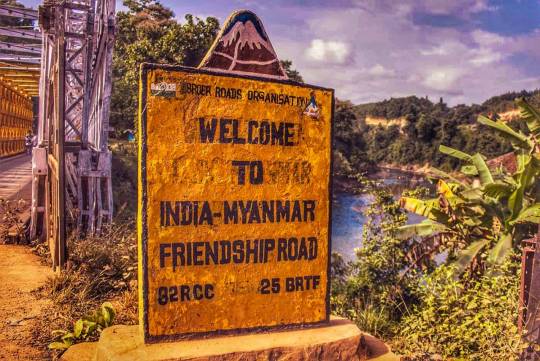
While I loved the valley but my heart remains tucked somewhere in the hills of Manipur. It was my home for more than two years and the hills and its people loved me back the way I loved them and more. Manipur hills with all its insurgency and army operations happening have been a scary and mysterious abode. And I am glad it opened it’s arm to peacefulness in my presence. https://herlittlespace.com/2019/06/20/the-best-of-manipur-series-i/ Do read the first part of this series ! Just two hours from Imphal lies Tengnoupal, a beautiful, serene hill town that I called home. It happens to be the highest point on NH-2, the ASEAN highway that enters Myanmar, through Moreh. The road is popularly known as the Moreh road and you can book a vehicle easily from Imphal to travel here. There are also buses running daily and share taxis are plenty! While traveling from Imphal, the road is plain and straight till Palel. And you cross little towns like Thoubal, Kakching, Khongjom, etc. Thoubal happens to be a district town which is crowded and the market is really big, while Kakching has a beautiful garden known as the Kakching Garden and, bang on the road in Khongjom you come across the glorious gate of the Khongjom War 1891 Memorial. While driving down it falls on the left-hand side and it’s worth paying a visit. Not just for the architecture but to pay homage to the great sacrifice to the martyrs of 1891 War.

The first bullet of the war was fired by the British on the 24th March 1891, without any provocation from the Manipuris. In the days fighting at the capital of Manipur, about 50 Manipuris including Pukhramba Tanka, Khumbong Subedar, Leisang Jamadar and Athokpa Dewan sacrificed their lives. Two Tangkhuls were also among those killed in hand to hand fight. Lt. Brackenbary and some sepoys of the British Army lost their lives on the side of the British. In the aftermath of the palace attack, owing to the demand of the Manipuri masses, seven unguarded British Officers were killed.The Battle of Khongjom was the greatest battle of the Anglo-Manipur War. Great freedom fighters-Major Paona Brajabasi, Chinglen Sana, Khumbong Major, Loitongba Jamadar, Keisa Jamadar, Heirang Khongja and many more rank and files of Manipuri warriors sacrificed their lives at this battlefield. Source - https://thoubal.nic.in/tourist-place/khongjom-war-memorial-complex/ After Khongjom the drive is beautiful with green meadows on both sides and hills at a distance. Different shades of green fill your heart and if you are lucky, you might get to see a rainbow! The hilly roads start from Palel and the scenic beauty of the road is unparallel. During monsoons it’s misty, clouds come down to say hello and the temperature changes drastically. And exactly two hours or 70kms from Imphal on this road you reach Tengnoupal, there is an Assam Rifle post for a regular checkup and just 5 minutes from the check post is the very beautiful Gaby’s Café where you can stop for a quick bite.

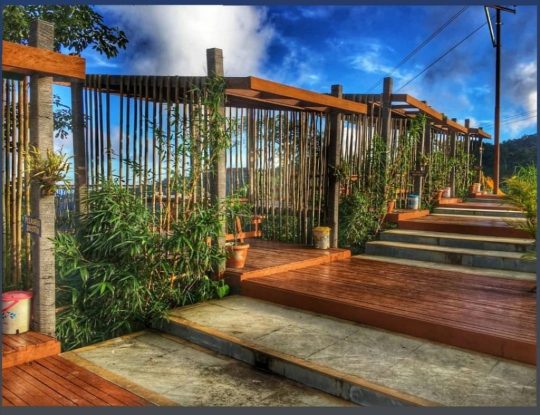
https://herlittlespace.com/2019/06/06/these-beautiful-cafes-in-manipur-are-all-about-coziness-and-good-food/ You can learn more about the cafe here!

Tengnoupal town Tengnoupal had been home for more than two years and I had so many guests come over for a stay, they just wanted to soak in the beauty of this tiny little village town which has recently been made into a district. And quite a few kept asking if there was a homestay or a hotel around this beautiful hill but there wasn’t any until now! Gaby’s Café now has rooms to stay and that’s not all, you can also carry your tent and camp for the night in their compound. And if you are a mountain lover like me you must stay at least for a night in this beautiful café and explore the villages around. You shall meet some really lovely people with the warmest smiles.
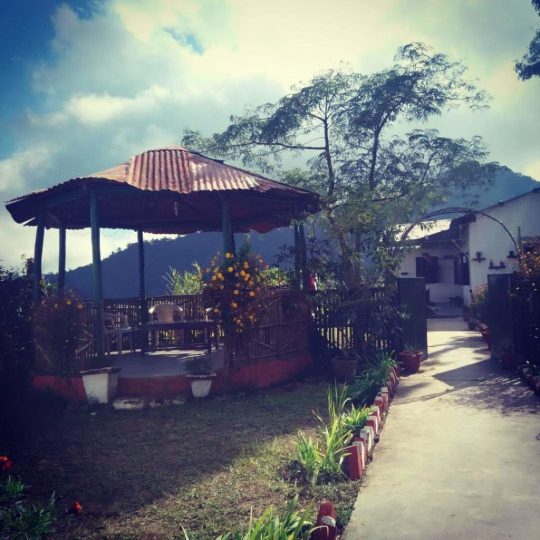
Home!

Strolling down the village... Tengnoupal lies just 37kms from Moreh, the border town that shares its boundary with Myanmar. It takes a little more than an hour in the hilly roads to reach Moreh. There is one more Assam Rifle check post and you cross the very beautiful Chamol river on the way. MOREH TOWN

Often referred to as India’s gateway to Southeast, Moreh is more than just a border town. This commercial capital of Manipur is mainly inhabited by the Kuki community but there is a noticeable number of Tamils, Meiteis, Punjabis, Telegus, Bihari and Nepali settled there. This rapidly developing trade point in India is growing at an unbelievable pace.
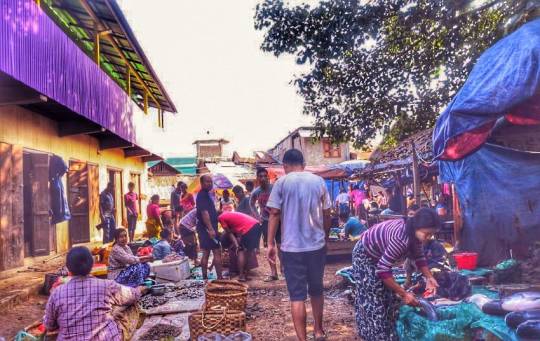
The fish market in Moreh

The vegetable mandi I made frequent trips to Moreh because the Lamphalong Market was such a temptation! And just an hour away I could actually enter a differ country without any Visa or Passport, how could I not make the most of it.
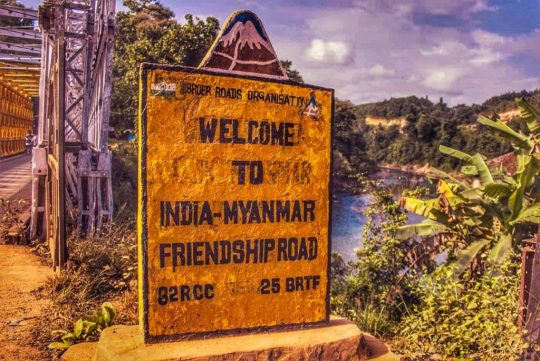
However, the first thing that I noticed about this little town bustling with people was the number of Tamil posters around. In a little state like Manipur, where most people were not very familiar with Hindi, how was Tamil so popular? I did not know whom to ask until I met Shree Aunty. One day in my usual trip to Moreh I asked my driver, where did he have his food? He was from Uttar Pradesh and I saw he was never comfortable in having food in the local market places. “God knows what meat they will feed me”, he said. So, I asked him if he stayed hungry till he gets home? He said he had food at a Tamil family restaurant and I thought of accompanying him. The little restaurant served proper home cooked food including dosas and thalis( both veg and non veg). On the very first day I asked for a permission to take a picture of the old lady sitting in the counter,he had the most typical tamil features and spoke to her employees in Burmese. She denied for a picture and I did not wamt to push. I started visiting her restaurant regularly and it did not take long for the ice to break and at times I visited Moreh just to sit and chat with her. I have always been curious about the Burmese Tamils here and I had googled about them but I wanted to know more. And I would keep asking her until one day she was ready for a picture and talk about her ancesters.
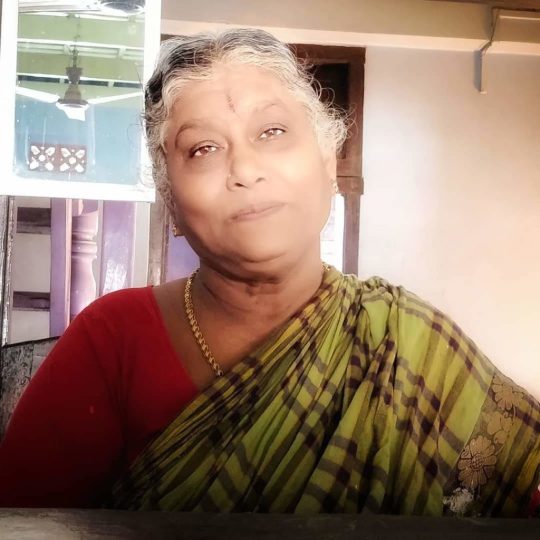
“My mom used to say they called us Kala Lumyo, because we are dark. But still that is our home and those people are our people! Things will get better and we will be able to go back to our own home." Often she looked lost in her thoughts... Maybe pondering on the times gone by. "I was born in India, in Moreh. But my mother used to say that I belonged to Burma. I speak Burmese better than Tamil. My mother was from a village in South india and my father was from Chennai but they had their home in Burma. They fell in love and married in Burma. Burma was their country. Burma was home!" I had very casually asked her... "And where do u belong aunty?" She smiled with teary eyes and said, " I don't know... “ In the 19th century during British colonialism thousands of Indians from Tamil Nadu began to leave and migrated to Burma(now Myanmar) attracted by the country’s labour prospects. They successfully involved themselves in the rice cultivation and trade. But their fortune did not last too long, with the decline of the British Empire they began losing on their business. During a military coup in the 1960s under General Ne Win, the Tamil population were forced out of the country. There are quite a few articles written about these Burmese Tamils and if you want to read more about them, here is a link to one of the best I found - https://homegrown.co.in/article/47804/manipurs-mini-tamil-nadu-how-burmese-tamils-ended-up-in-moreh Other than the interesting blend of culture and heritage this little border town of India has one of the most flourishing market places in the country. According to economists, this little town will turn into a bustling city in the coming years and you know they are correct once you enter the town.
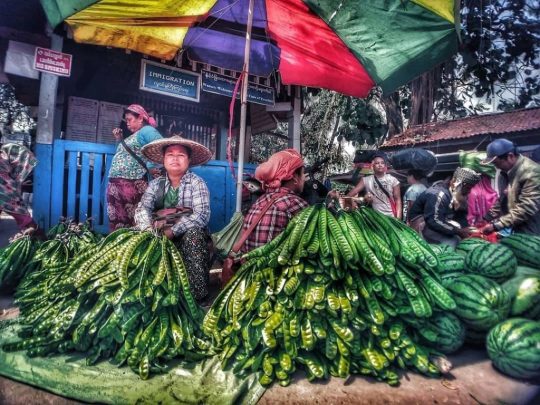
The market place in Moreh happens to be one of the main attractions of Manipur and for all the right reasons. I myself explored the market there and I can tell you there you nothing you won’t find there, both legal and illegal. And the biggest market here is the Namphalong Market from where daily there is a business of around 90 crores. NAMPHALONG MARKET
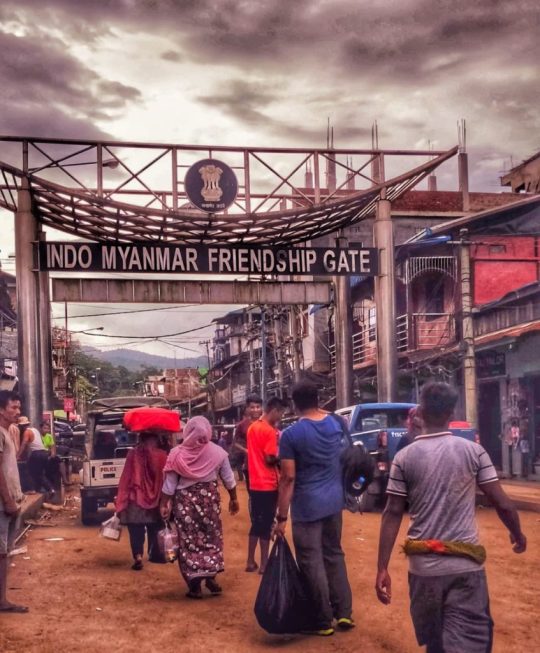
The Namphalong market is on the other side of the border and to enter the market you actually enter Myanmar. If that is not interesting enough you can actually explore the border town of Myanmar, Tamu for the day without a Visa and a passport. Though this is far from experiencing mainstream Myanmar but good enough if you want to explore the local cuisine and a part of the culture, market place and places of worship. The namphalong market was described as a shoppers' paradise to me and why not?! You actually find an insane variety of things in this market and for a tax-free price!
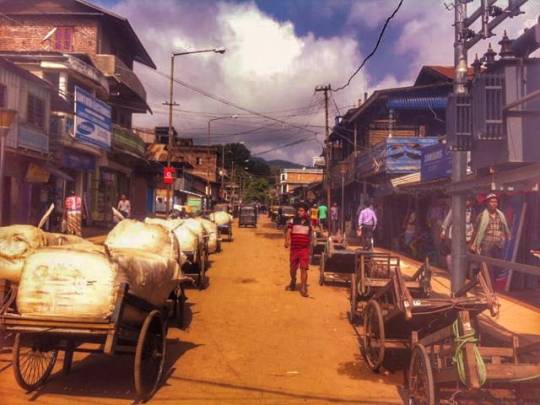
Every day thousands of sacks packed with goods are transported through these thelas, trucks and buses.

In my two and half year stay, I must have visited the market hundreds of times and I actually went crazy with the variety of fruits and vegetables that were available and how cheap they were.
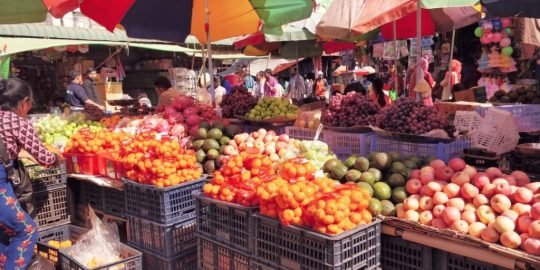

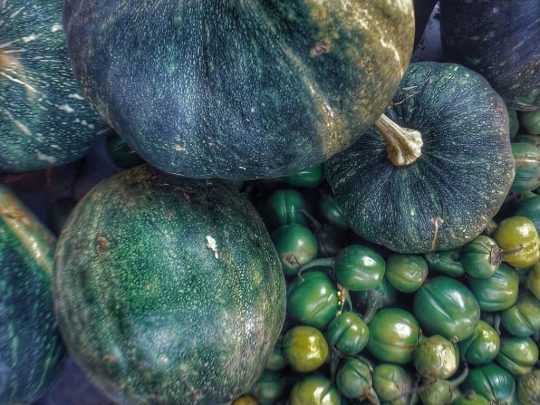
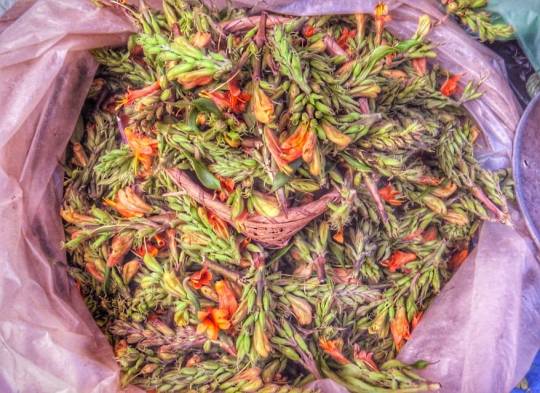
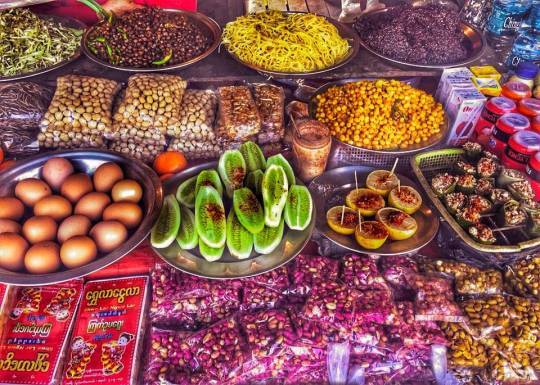


Then there are electronics of every kind, there are enough types of kitchen items to set your kitchen up for good, there's a full lane for crockery! A lane dedicated to home décor stuffs like posts and planters, artificial flowers, wall décor. A lane dedicated to clothes and fabrics. One for makeup and skincare, one for shoes and bags, and one dedicated to food! And if you are a shopaholic you might just go crazy with the kind of options you get for the price.
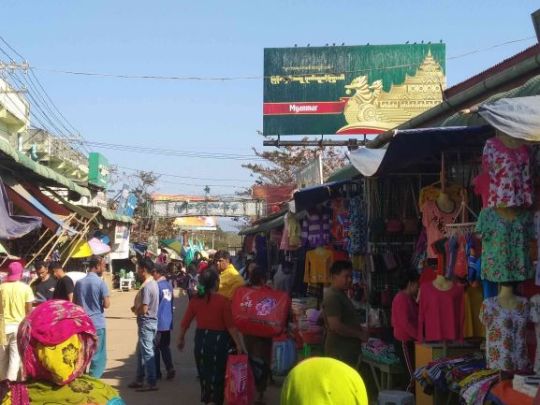
Shopping is not the only attraction this place has to offer, you can actually take a pass from the immigration office in the market go for a tour around the town of Tamu. I absolutely loved doing this, most of the times I would take an auto to just drop me in the main market and explore everything on foot. It’s easy to find an auto back to the lamphalong market at the end of the time. Right when you enter the Lamphalong market you come across the little immigration counter. The counter charges around 20/- INR, keeps an identification card and you are told to be back by 4pm(Indian time). You have an auto stand at the end of the market place and they charge you 300/-INR for an hour and 500/- INR for hiring them full time. TAMU

The bridge that connects both the countries. The white part is Indian side and the yellow part is where Myanmar starts. Suddenly the auto driver starts driving on the left-hand side of the road, you cannot read the banners around you and the auto driver nor any other person does not understand Hindi or English, you have entered Myanmar. However, there are quite a few Nepalis settled there and if you are lucky you might meet a few and they happily take you around the town.

For me, the language barrier hasn't been much of a hindrance, I roamed around the market and bought things without understanding a word they said and it was fun! I loved the feeling of being in a different country where I could not understand the language but it worked out amongst us quite beautifully. We laughed at each other for being confused and yet, in the end, it was manageable. Other than the market place, Tamu has a few beautiful monasteries that are worth a visit.
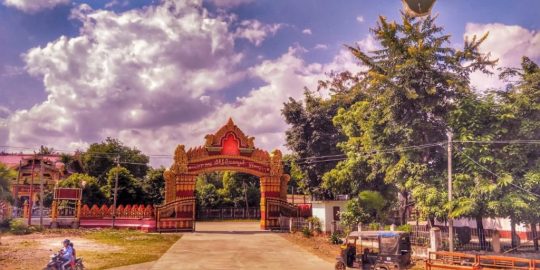

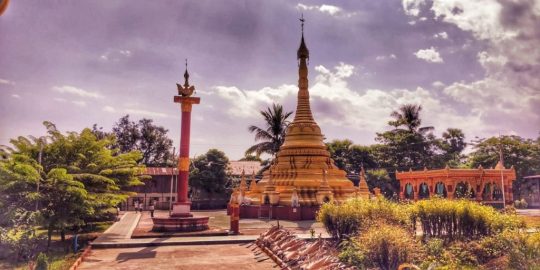

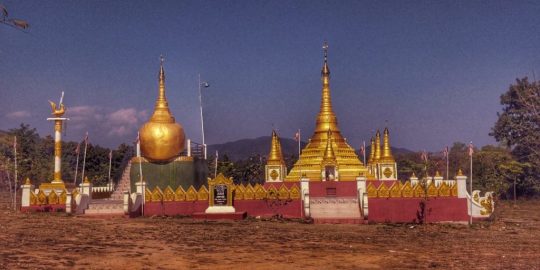
Tamu market will give you a little glimpse of the culture of Myanmar and there are a few good restaurants there too. There is one right in the main market area called 'The Water World'. The food is delicious and paying in Myanmar currency you end up eating so much for so less money! Almost every tour agency take their guests to this restaurant and so I am sure you won't miss this one. During these visits, I made a few friends in Myanmar too and one of them was a baker. I loved her cakes so much that she took me to her little factory in her house itself.
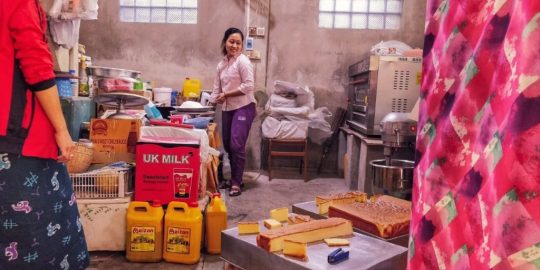
I had written quite a few blogs on Manipur, but never about this part of the state. Not because I did not want to but this part of the state was home and I was scared if I would be able to do justice to it. Hoping that the blog grows your interest in the beautiful state that Manipur is. And the next in the series shall be the other sides of the state. though I have already written about most of them but will combine all in this series so that it helps. Liked the blog? Pin it!
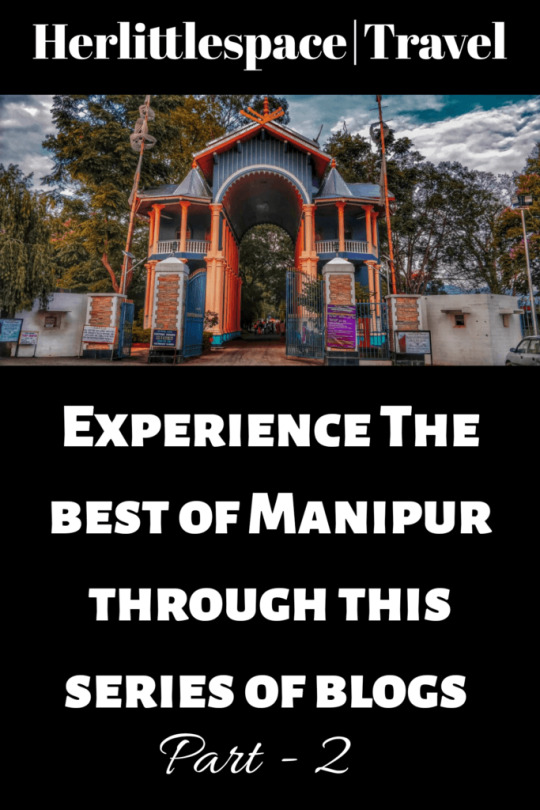
Read the full article
#bestofmanipur#bestplacetofindmanipurithaliinimphal#bestplacesinnortheast#bestplacestovisitinimphal#bestplacestovisitinManipur#blogsonimphal#blogsonmanipur#blogsonMoreh#cafesinimphal#experiencethebestofmanipur#forageimphal#howtoreachmoreh#imphal#imphalblogs#imphaltourism#Indo-mayanmarfriendshiproad#indo-myanmarbordertownmorehandtamu#manipur#manipurbestbogs#manipurbestitinerary#ManipurDiaries#manipuritinerary#manipurnortheast#Manipurtourism#Manipurtrips#Morehandtamu#Morehtown#placestoseeinmanipur#placestovisitinimphal#placestovisitinImphalinaday
0 notes
Text
Catering Equipment Market Latest News, Cost Profit Structure and Market Share Till 2027
Catering equipment is used to prepare, serve, and store food in hotels, restaurants, hospitals, cafes, and nursing homes. The global catering equipment market is expected to witness tremendous growth in the near future. Increasing number of hotels and restaurants, cafes and food joints, and hospitals and nursing homes are contributing to the growth of this market. Some of the catering equipment is also used to wash food items, utensils, and crockery.
The demand for catering equipment is driven by the overall improvement in an economy and the strong resilience of the hospitality sector. Key factors influencing the market include the increasing levels of consumer confidence and the very strong growth in the eating out sector. The market is expected to grow at a significant pace in the next few years due to product development with higher hygiene standards, the development of restaurant and hotel chains, and the demand for small and more sustainable products.
New product development is a major growth driver of demand for catering equipment. The current focus is directed toward the development of equipment and products that help to comply with health and hygiene, and safety regulations. Technological advancement such as wash zones or separate drawers to allow the dishwasher to run a half-load, steam cycles to clean, dry, and sanitize dishes in dishwashers, utensil cleaners etc., have also resulted in reducing the level of water usage.
Request A Sample Copy Of The Report https://www.transparencymarketresearch.com/sample/sample.php?flag=S&rep_id=46092
Price competition, particularly from low value imports, and life-span of products is affecting the growth of the catering equipment market negatively. Longer life span of products reduces the replacement cycle. Absence of stringent government regulations is one of the major factors affecting the growth of the catering equipment market across the globe. Further, poor quality of low cost catering equipment, high cost of advanced equipment, and less demand in under developed countries acts as major restraints to the market.
The global catering equipment market can be segmented based on product type, end users, distribution channel, and geography. In terms of product type, the market can be classified into cooking equipment, food handling equipment, refrigeration equipment, food preparation equipment, and other catering equipment. Cooking equipment and food handling equipment are the two largest sectors of the market. The cooking equipment can be further segmented into grills, fryers, steamers, toasters, cookers, and others. Food handling equipment can be classified into food containers, food conveyors, cabinets, trolleys, and others. Refrigeration equipment can be divided into freezers, chillers, refrigerators, and others. Food preparation equipment include mixers, peelers, cutters, etc. whereas other catering equipment include bar equipment, tea and coffee making equipment etc. Based on end-use, the market is segmented into full-service restaurants & hotels, quick-service restaurants, pubs, and caterers. In terms of distribution channel, the market can be divided into online and offline channels. Offline market is further segmented into hypermarket and supermarket, convenience store, and others. Geographically, the market can be divided into North America, Europe, Asia Pacific, Middle East & Africa, and South America.
Key players operating in the catering equipment market include Kohler Co., GE Appliances, Robert Bosch GmbH, Siemens AG, and DE&E Appliances Co., Ltd. Other prominent players include Ningbo Fotile Kitchen Ware Co., Ltd, Sakura, Space Group, Urban Ladder, Fabfurnish.com, FISSLER, Häcker Küchen, and Godrej & Boyce. There are also a large number of regional manufacturers of catering equipment, making the catering equipment market fragmented in nature.
The report offers a comprehensive evaluation of the market. It does so via in-depth qualitative insights, historical data, and verifiable projections about market size. The projections featured in the report have been derived using proven research methodologies and assumptions. By doing so, the research report serves as a repository of analysis and information for every facet of the market, including but not limited to: Regional markets, technology, types, and applications.
The study is a source of reliable data on:
Market segments and sub-segments
Market trends and dynamics
Supply and demand
Market size
Current trends/opportunities/challenges
Competitive landscape
Technological breakthroughs
Value chain and stakeholder analysis
The regional analysis covers:
North America (U.S. and Canada)
Latin America (Mexico, Brazil, Peru, Chile, and others)
Western Europe (Germany, U.K., France, Spain, Italy, Nordic countries, Belgium, Netherlands, and Luxembourg)
Eastern Europe (Poland and Russia)
Asia Pacific (China, India, Japan, ASEAN, Australia, and New Zealand)
Middle East and Africa (GCC, Southern Africa, and North Africa)
The report has been compiled through extensive primary research (through interviews, surveys, and observations of seasoned analysts) and secondary research (which entails reputable paid sources, trade journals, and industry body databases). The report also features a complete qualitative and quantitative assessment by analyzing data gathered from industry analysts and market participants across key points in the industry’s value chain.
A separate analysis of prevailing trends in the parent market, macro- and micro-economic indicators, and regulations and mandates is included under the purview of the study. By doing so, the report projects the attractiveness of each major segment over the forecast period.
Request For Covid19 Impact Analysis https://www.transparencymarketresearch.com/sample/sample.php?flag=covid19&rep_id=46092
Highlights of the report:
A complete backdrop analysis, which includes an assessment of the parent market
Important changes in market dynamics
Market segmentation up to the second or third level
Historical, current, and projected size of the market from the standpoint of both value and volume
Reporting and evaluation of recent industry developments
Market shares and strategies of key players
Emerging niche segments and regional markets
An objective assessment of the trajectory of the market
Recommendations to companies for strengthening their foothold in the market
Note: Although care has been taken to maintain the highest levels of accuracy in TMR’s reports, recent market/vendor-specific changes may take time to reflect in the analysis.
This study by TMR is all-encompassing framework of the dynamics of the market. It mainly comprises critical assessment of consumers' or customers' journeys, current and emerging avenues, and strategic framework to enable CXOs take effective decisions.
Our key underpinning is the 4-Quadrant Framework EIRS that offers detailed visualization of four elements:
Customer Experience Maps
Insights and Tools based on data-driven research
Actionable Results to meet all the business priorities
Strategic Frameworks to boost the growth journey
The study strives to evaluate the current and future growth prospects, untapped avenues, factors shaping their revenue potential, and demand and consumption patterns in the global market by breaking it into region-wise assessment.
The following regional segments are covered comprehensively:
North America
Asia Pacific
Europe
Latin America
The Middle East and Africa
The EIRS quadrant framework in the report sums up our wide spectrum of data-driven research and advisory for CXOs to help them make better decisions for their businesses and stay as leaders.
Below is a snapshot of these quadrants.
1. Customer Experience Map
The study offers an in-depth assessment of various customers’ journeys pertinent to the market and its segments. It offers various customer impressions about the products and service use. The analysis takes a closer look at their pain points and fears across various customer touchpoints. The consultation and business intelligence solutions will help interested stakeholders, including CXOs, define customer experience maps tailored to their needs. This will help them aim at boosting customer engagement with their brands.
2. Insights and Tools
The various insights in the study are based on elaborate cycles of primary and secondary research the analysts engage with during the course of research. The analysts and expert advisors at TMR adopt industry-wide, quantitative customer insights tools and market projection methodologies to arrive at results, which makes them reliable. The study not just offers estimations and projections, but also an uncluttered evaluation of these figures on the market dynamics. These insights merge data-driven research framework with qualitative consultations for business owners, CXOs, policy makers, and investors. The insights will also help their customers overcome their fears.
3. Actionable Results
The findings presented in this study by TMR are an indispensable guide for meeting all business priorities, including mission-critical ones. The results when implemented have shown tangible benefits to business stakeholders and industry entities to boost their performance. The results are tailored to fit the individual strategic framework. The study also illustrates some of the recent case studies on solving various problems by companies they faced in their consolidation journey.
4. Strategic Frameworks
The study equips businesses and anyone interested in the market to frame broad strategic frameworks. This has become more important than ever, given the current uncertainty due to COVID-19. The study deliberates on consultations to overcome various such past disruptions and foresees new ones to boost the preparedness. The frameworks help businesses plan their strategic alignments for recovery from such disruptive trends. Further, analysts at TMR helps you break down the complex scenario and bring resiliency in uncertain times.
You May Also Like PRNewswire on https://www.prnewswire.com/news-releases/sake-brewery-industry-to-play-a-positive-role-in-cubitainers-market-growth-from-2020-to-2028-transparency-market-research-301104740.html
You May Also Like PRNewswire on https://www.prnewswire.com/news-releases/penetration-of-advanced-technologies-to-bring-a-paradigm-shift-in-growth-of-warranty-management-system-market-north-america-to-add-numerous-feathers-of-growth-opines-tmr-301110185.html
The report sheds light on various aspects and answers pertinent questions on the market. Some of the important ones are:
1. What can be the best investment choices for venturing into new product and service lines?
2. What value propositions should businesses aim at while making new research and development funding?
3. Which regulations will be most helpful for stakeholders to boost their supply chain network?
4. Which regions might see the demand maturing in certain segments in near future?
5. What are the some of the best cost optimization strategies with vendors that some well-entrenched players have gained success with?
6. Which are the key perspectives that the C-suite are leveraging to move businesses to new growth trajectory?
7. Which government regulations might challenge the status of key regional markets?
8. How will the emerging political and economic scenario affect opportunities in key growth areas?
9. What are some of the value-grab opportunities in various segments?
10. What will be the barrier to entry for new players in the market?
0 notes
Text
Bamboo Straws Market Forecast Revised in a New FMI Report as COVID-19 Projected to Hold a Massive Impact on Sales in 2020
The market report envelopes an all-in information of the global Bamboo Straws market and the nature of the market growth over the foreseeable period. The report provides a comprehensive elaboration of the positives and negatives of the global Bamboo Straws market with DROT and Porter’s Five Forces analysis. With SWOT analysis, the report offers detailed insights about different players operating within the Bamboo Straws market. In addition, the analysts of the report have served the qualitative and quantitative scrutinizing of different micro- and macro-economic factors influencing the global Bamboo Straws market.
The COVID -19 pandemic has put forth a demanding situation for players in Bamboo Straws market. The widespread of the pandemic and the humanitarian toll taken by it is making it challenging for market players to respond. This research study provides insights backed by our assessment of earlier emergencies and market expertise. However, the pandemic is spreading rapidly, and some of the information in this study may become outdated.
To know more about this market, request a sample@ https://www.futuremarketinsights.com/reports/sample/REP-GB-6936
Key segments covered in the global Bamboo Straws market report by length type include
Up to 9 cm
15 cm
20 cm
The Bamboo Straws market report examines the consumption pattern of each segment and the factors affecting the pattern. In addition, the report focuses on the production footprint of each segment in various industries and regions across the globe.
By end-use, the global Bamboo Straws market consists of the following:
Restaurants
Hotels
Bars & Cafes
Others
The Bamboo Straws market report helps the readers grasp the changing trend in the industry supply chain, manufacturing techniques and expenses, and current scenario of the end uses in the global Bamboo Straws market.
Prominent players covered in the global Bamboo Straws market contain
Straw Free
Buluh Straws
AnjiWuyuan Bamboo Products Factory
Bamboo Straws Worldwide
Zone Bamboo Straws
All the players running in the global Bamboo Straws market are elaborated thoroughly in the Bamboo Straws market report on the basis of proprietary technologies, distribution channels, industrial penetration, manufacturing processes, and revenue. In addition, the report examines R&D developments, legal policies, and strategies defining the competitiveness of the Bamboo Straws market players.
We offer tailor-made solutions to fit your requirements, request customization@
https://www.futuremarketinsights.com/customization-available/rep-gb-6936
The Bamboo Straws market analyses the following important regions:
North America (U.S., Canada)
Latin America (Mexico. Brazil)
Western Europe (Germany, Italy, France, U.K, Spain)
Eastern Europe (Poland, Russia)
Asia Pacific (China, India, ASEAN, Australia & New Zealand)
Japan
Middle East and Africa (GCC Countries, S. Africa, Northern Africa)
The Bamboo Straws market report answers the following queries:
1. Why consumers are highly inclined towards the consumption of segment in the Bamboo Straws market?
2. What are the opportunities available for players operating in the global Bamboo Straws market?
3. Which trends have the maximum impact on the growth of the global Bamboo Straws market?
4. Why region leads the global Bamboo Straws market?
5. What are the drivers and restraints affecting the market size of the global Bamboo Straws market?
What the report encloses for the readers:
Critical insights of each segment, including volume growth outlook, and demand & supply pattern.
A to Z of each player –positives & negatives, current status, future developments – of the global Bamboo Straws market.
Detailed information regarding the trends influencing the growth of the global Bamboo Straws market.
In-depth assessment on the utilization of Bamboo Straws in each end use industry.
Historical data and future growth outlook of the global Bamboo Straws market.
Get Full Access of the Report @https://www.futuremarketinsights.com/reports/bamboo-straws-market
Why choose Futuristic Market Insights?
Digital intelligence solutions to help clients stay at the forefront.
Published 6, 000+ reports and recognized by 150+ countries globally.
A team of 300+ analysts to deliver real-time information across various industries and companies.
Customized business reports to overcome unique market challenges
Act Today to Succeed Tomorrow, Know the COVID-19 Impact @ https://www.futuremarketinsights.com/covid19/rep-gb-6936
About Future Market Insights (FMI)
Future Market Insights (FMI) is a leading provider of market intelligence and consulting services, serving clients in over 150 countries. FMI is headquartered in London, the global financial capital, and has delivery centers in the U.S. and India. FMI's latest market research reports and industry analysis help businesses navigate challenges and take critical decisions with confidence and clarity amidst breakneck competition. Our customized and syndicated market research reports deliver actionable insights that drive sustainable growth. A team of expert-led analysts at FMI continuously track emerging trends and events in a broad range of industries to ensure that our clients prepare for the evolving needs of their consumers.
Contact Us
Mr. AbhishekBudholiya
Future Market Insights
616 Corporate Way, Suite 2-9018,
Valley Cottage, NY 10989,
United States
T: +1-347-918-3531
F: +1-845-579-5705
T (UK): + 44 (0) 20 7692 8790
Sales: [email protected]
Press Office: [email protected]
Blog:https://www.packagingworldnews.com/
Website: https://www.futuremarketinsights.com/
0 notes
Text
Discover Singapore in 7 days – Full timeline and travel tips
If you have 7 days to visit this beautiful island, what will you do? How to explore to the full of culture, cuisine, landscape, and lifestyle of local people here? If you are wondering how to get a wonderful experience on a 7-day trip in Singapore, just check our list and let us guide you on how to enjoy every fascinating and signature thing in this country.
More informations:
Top 6 Singapore Hotels best choices on Agoda
10 things that make you want to travel in Singapore
Day 1: Visit off-the-beaten-track ‘hoods
Tiong Bahru Wet Market
Morning – Joo Chiat/Katong
Start your day wonderfully with a local breakfast in Joo Chiat. Try prata at the Mr. and Mrs. Mohgan’s Super Crispy Prata, a food stall located in Tin Yeang Restaurant. Then don’t forget to spend your morning exploring the area and admiring the vibrant rows of heritage shophouses.
Afternoon – Tiong Bahru
Head to Tiong Bahru, one of the oldest housing areas in Singapore for the afternoon itinerary. The neighborhood is a beautiful combination of the past and the new with art-deco stores, sites rich in wonderful architecture and clusters of trendy cafes, all of which coexist in one location. Start the afternoon with a visit to BooksActually before going to the Qi Tian Gong Temple to admire some landmarks.
Evening – Dempsey Hill
The Dempsey enclave is a must-visit dinner spot. Including the JUMBO Seafood chili crab to the beautifully decorated dishes of Western European of The White Rabbit or fiery Samy’s Curry Indian cuisine — this wonderful lifestyle destination has unlimited options!
Don’t just leave after you’re done with dinner. The Rabbit Hole in the White Rabbit offers a wide range of soothing gins, mixed with your own tonic. The RedDot BrewHouse is well known for its drinking options, which is ideal for craft beer lovers.
Day 2: Singapore city tour
Morning – Visit Gardens by the Bay
The perfect beginning for your day is Gardens by the Bay. The unique Supertrees can not be missed — these vertical gardens are up to 50 meters in height, and both of these structures are linked by an aerial path that provides a perfect view of the Singapore skyline. Don’t forget to visit the Flower Dome – the world’s largest glass greenhouse – and the cloud forest, which is considered as the world’s tallest indoor.
Afternoon – Check the view from Singapore Flyer
Visit the Singapore Flyer for more spectacular views from above. Step into a capsule with this massive observation wheel, which rises up to 165 meters high (42 storeys high) and enjoys a completely fantastic view of the city.
The Singapore Food Treats — a concept for dining inside the Flyer building, is the spot for lunch. This elegant food place is built to feel as if you have been in Singapore in the 1960s. The restaurant sells local delights such as Hainanese chicken rice, satay bee hoon (rice vermicelli noodles in a spicy peanut sauce) and bak kut teh (peppery pork rib soup).
Evening – Take a tour around Marina Bay Sands
Take a stroll around the bay for your renowned Chef Restaurants at Marina Bay Sands ®. Choose one dinner spot — Gordon Ramsay’s Bread Street Kitchen offers Asian-style European cuisine, or CUC is by Wolfgang Puck if you can’t resist a great steak.
Once you have dinner, go out for SkyPark to finish the night at CE LA VI with a bang. Apart from fantastic music and delicious drinks, the sky-high rooftop bar is the venue for spectacular sunsets and incredible views of the city.
See more: Top 10 reasons to visit Marina Bay Sands when traveling to Singapore.
Day 3: Go green in Singapore
Singapore Botanic Gardens
Morning – Visit Singapore Botanic Gardens
The perfect time to visit The Singapore Botanical Gardens is in the early hours. The 150 years old green space is a UNESCO World Heritage site which includes such attractions as statues, a swan lake, numerous tropical plants, and a National Orchid Gardens.
Afternoon – Bukit Timah Nature Reserve
A hiking game? Your afternoon will be very interesting with experience the 163 hectares of natural reserve of Bukit Timah, an ASEAN Heritage Park which comprises 40% of the flora and fauna of Singapore, and the highest hill in the nation (164 m).
Evening – Henderson Waves
Take a ride to the South Ridges and explore the tall, brilliantly Henderson Waves in the beauty of sunset.
Complete the 10-kilometer walk that takes you through Mount Faber Park, Telok Blangah Hill Park, HortPark, Kent Ridge Park, and Labrador Nature Reserve if you have enough energy to discover.
Day 4: Have fun under the sun
Sentosa Island
All-day – Discover Sentosa Island
Enjoy Sentosa – the most popular resort in the island of Singapore with endless things to see and do. Next on the agenda for you: Singapore Universal Studios.
The film-themed amusement park features seven areas and several exciting experiences, including the 3D rollercoaster Transformer: The Ride, and the Jurassic Park Rapids Adventure— a white water raft system with a spectacular experience waiting for you at the finish.
Go to the Quayside Isle for lunch. This complex offers a variety of restaurants from multi-concept bakery and Greenwood Fish Market s to Mykonos On The Bay which is a Greek restaurant.
Tanjong Beach Club is a perfect place for you to enjoy in the afternoon. This is the best spot for people sitting and sunbathing in the daybed of the pool while eating classic European bites like lobster buns and steak tartare.
Head to S.E.A. Aquarium before sunset to see more than 100.000 aquatic species, including manta rays and leopard sharks, and finally to experience the Image of Singapore, a 4D theater featuring interactive, decorated areas and the Spirit of Singapore Boat Ride, which takes you on the journey around the cultural and historical sites of Singapore.
Day 5: Museum Hop
National Gallery Singapore
Morning – Go to National Gallery Singapore
The best way to explore the culture of a city is visiting museums. Start your journey with the collection of the Singapore National Gallery. With over 8,000 pieces of art, the Singapore National Gallery is home to the world’s largest public collection of contemporary art in Singapore and Southeast Asia; which includes 2 national monuments – the former Supreme Court and the City Hall.
Afternoon – Visit Singapore Art Museum
After that, you should visit the Singapore Museum of Art. The nation’s first ever Art Museum is more widely known as “SAM” and houses one of the largest collections of South-East Asian modern art in the world. Take the time to appreciate the architecture – the buildings were once a mission school in the 19th century and have been magnificently conserved with many original features such as the floor tiles and the patina on the roof.
Evening – Last but not least: National Museum of Singapore
Finish your day with the Singapore National Museum to learn about the rich history and culture of this beautiful country. Expect multimedia exhibits and interesting video presentations.
Day 6: Time to shop
Singapore Orchard Shopping Mall
Morning – Orchard Road
Start things with a tour to Orchard Road – the most popular shopping area in Singapore. This is the paradise for any shopaholic in this iconic tourist place, from the multinational designer chains at Robinsons to the popular TANGS labels to the bargain-hunting at * SCAPE. If you want to find some local products, don’t forget to visit Design Orchard.
Afternoon – Bras Basah.Bugis
When we talk about value shopping, Bugis and Haji Lane are perfect places if you want to exchange at a reasonable price.
The two neighborhoods are known for their trendy shops and specialty stores that sell chic outfits, vintage items and boutiques like Spoilmarket. These two are situated very close to each other and easy for you to shop.
Evening – Joo Chiat/Katong
Visit Rumah Bebe and Kim Choo Kueh Chang – beautiful historical houses – situated next to each other in the Joo Chiat and Katong. You will not only learn briefly about visual history on the Peranakan legacy but also find many interesting things ranging from detailed accessories, lavish decorations to kueh chang (rice dumplings of the “Straits Chinese”).
Day 7: Explore the cultural precincts
Chinatown in Singapore
Morning – Singapore Chinatown
Split the day in three big Singapore cultural areas: Chinatown, Little India, and Kampong Glam
In the morning, stroll around the Chinatown and visit the Maxwell Food Centre Don’t forget to enjoy the breakfast staple of a congee from the famous Zhen Zhen Porridge Stall. Then visit Chinatown on foot for a bit of history and tradition, to see sites like the majestical Buddha Tooth Relic Temple.
Afternoon – Little India
In the afternoon, a visit to temples such as Sri Veeramakaliamman Temple is wonderful to discover Little India. Loads of tiny retail shops selling lovely saris, spices and accessories (a common long dress worn by local women, they wrap it over the body) and don’t forget to look around to see what is available. Without an authentic Indian dinner, you can not leave Little India, of course. Banana Leaf Apolo is a fantastic choice and the curry fish head is too good to refuse.
Evening – Kampong Glam
At night, it’s time to end your day at Kampong Glam to see places of significance such as the Malay Heritage Centre and the glorious Sultan Mosque on Muscat Street. You can have a convenient dinner at Zam Zam restaurant, located opposite the mosque’s lane, which serves Indian Muslim classics such as murtabak (stuffed pan-fried flatbread) and nasi briyani (an Indian spiced rice dish with meat or vegetables).
Final destination: Changi Airport
End up your trip in Singapore at Changi Airport with a duty-free shopping area. At this place, you will find luxurious products, perfumes, and colognes, desserts and chocolates- all of which are perfect choices as souvenirs for your beloved ones when you go back home.
The post Discover Singapore in 7 days – Full timeline and travel tips appeared first on Make a wonderful trip in Singapore.
from WordPress https://tripinsingapore.com/discover-singapore-in-7-days/
0 notes
Text
U.S. Meat Export Federation Hosts Tasting Night at Bonifacio Global City
Bonifacio Global City has rapidly grown as a modern wonder of contemporary living. With their sizeable office blocks and sprawling high streets and parks, BGC encourages living with a balance of work and play. It has attracted a lot of creative and passionate minds in the food industry to set up shop in the area, helping it steadily gain popularity as a hub of various gastronomic experiences. Restaurants in colorful BGC are well known for the quality of their dishes, all thanks to the fine ingredients they use such as U.S. Meat. That’s exactly what the U.S. Meat Export Federation (USMEF) wanted their attendees to experience last November 21, 2019 as they hosted Five Star Night, a showcase of local chefs and their take on U.S. Beef and U.S. Pork in partnership with some of BGC’s well-loved restaurants—Fireside, Jin Joo, and Mimi & Bros.
The event was opened by Mr. Morgan Haas, the Agricultural Counselor of the USDA Foreign Agricultural Service. As someone who grew up on a farm in Minnesota, he explains that the system set for U.S. Meat products is one of the best in the world, with safety and universal quality guaranteed. He also shares that he immediately felt at home in the Philippines because the first restaurant he went to proudly advertised that they were using USDA-approved meat, which garnered laughter from the audience. When asked about his favorite Filipino pork and beef dish, he quickly answers the famous Sisig and the comforting Bistek.
After the opening remarks, renowned chef and owner of 25 Seeds and Cafe Fleur, Chef Sau del Rosario, shared a few words on his experience with U.S. Meat as the ambassador of Five Star Night. According to him, meat that is able to stand on its own is very important with the way they prepare their dishes at Cafe Fleur. With the marbling, taste, and overall high-quality of U.S. Meat, he can always rely on it especially with his signature Crispy U.S. Pork Belly and Truffled Macadamia Kare-Kare, where the sauce should just elevate the pork. The attendees were then treated to three meat dishes prepared by the partner restaurants. First up was the Slow Cooked U.S. Pork Rib with Pumpkin Puree and Apple Chip by Chef Edward Bugia of Mimi & Bros. Chef Edward shares that his favorite way of preparing U.S. Meat is by cooking it low and slow, which is probably the other reason why their pork ribs are so tender. In addition, he raved about the clean taste of U.S. Meat which has the same quality every time.
Next was the Galbi Jjim by Chef JM Libron of Jin Joo, who explained why U.S. Beef Ribs are their beef of choice for the Korean stew. According to him, the good quality of the beef makes the flavors of the dish more appetizing.
Last but not the least is the Fireside House Burger by Chef Gigi Canlas, who shares that their burgers are made with fine U.S. Beef Patties and grilled to perfection on a woodfire grill. She adds that the burger was only seasoned with salt because the meat could already stand on its own.
In between the tastings, the guests were also challenged with fun trivia games about U.S. Beef and U.S. Pork. Questions include the feed used for U.S. Beef (corn-fed, the main reason why the meat is tender, flavorful, and juicy) and the best parts to use for various pork dishes (Belly for Bacon, and Loin for Pork Chops). Everyone gained new meat knowledge that could come in handy in grocery shopping, but the winners took home GCs from each of the partner restaurants. To cap off the night, ASEAN Director of the USMEF, Ms. Sabrina Yin, closed the event by thanking the guests for making their first event in the Philippines a success.
0 notes
Text
190919, Thursday.
Hey you, Z.
Good morning. Hope the sun rose as beautiful as you do everytime you wake up and smells as the sweet scent of yellow petals of that same rose.
I got up pretty early today, at about 0515 hours. Mainly because there was a sunrise to catch by the Mekong River. Unfortunately, due to the lack of planning, didn’t really manage to catch the sight of the sun rising. I did however caught the day light breaking. Just — no actual sunrise. Pretty sad.
Nonetheless, I walked down the street (I’d say walked down by the river but in all honesty, we’re about 500 metres to 1 kilometre away from the river on the pedestrian walking path — and it was filled with agricultural land), about 950 metres to visit a statue of Chao Anouvong.
This dude led the Lao Rebellion for about two years from 1826 till 1828 with three main strategies;
1) respond to immediate crisis — due to discontent over forced tattooing,
2) removing the ethnic Lao on the Khorat Plateau to the Kingdom of Vientiane — to slowdown the Siamese pursuit &&
3) seeking a diplomatic victory by gaining support from either Vietnam, China or Britain.
It’s quite a longwinded story of about this King tryna get themselves away from the Siamese power and felt that with Britain’s colonisation over SEA, it’s about time they fought their way out. Unfortunately, I don’t think it actually went to plan. Most of this can be read through the Wikipedia — I kinda just lost interest. Hehe. But some history lesson here. I took a couple of pictures! See below.


After the visit, back to the hotel I go, and up for breakfast. I didn’t have much today. Just a bowl of oats/grains with raisins and milk, a glass of orange juice, a cup of yogurt and that’s about it.
Went to the room to get some rest before I got ready to head and visit two other points of interest in the city.
Took the taxi to Pha That Luang temple. It’s a huge temple with a supposed golden paint which is essentially just yellow actually. Didn’t look real nice. But it was fairly extravagant compared to the other two temple/museums that were visited.
Looked through some of the stalls that were outside and everything is typically the same across the different stalls. Kinda disappointing. I’d imagine it would be more arts and craftsy stuff.
Took the same taxi to Patuxay. It’s like an arc in a park surrounded by the main road. Quite nice architecture but very old and asean looking. I went up to the top to take a picture and bought some key rings in the shop nearby for the colleagues back at work.
After the two visits, the taxi took us back to the hotel. I considered heading towards the gym or getting a couple of laps done through the pool but nobody seemed interested, so I took a long bath instead in the tub. Unfortunately, it wasn’t as refreshing as I’d imagine it to be. Haha. Rather unfortunate I’d say. I went by the pool and kindasorta sunbathed for about 30 minutes. There were mosquitoes so it was kinda annoying. Left soon after and chilled.
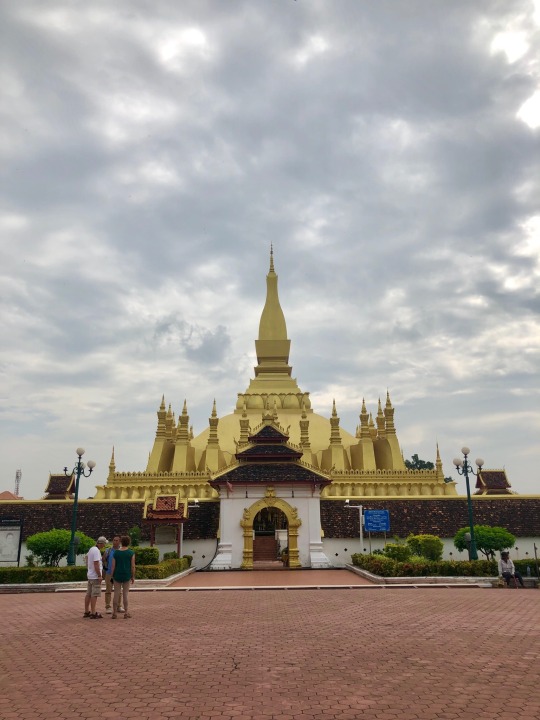
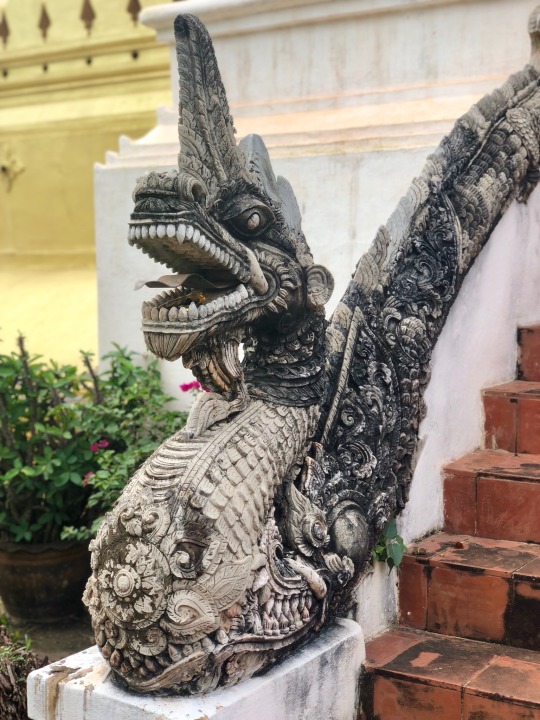
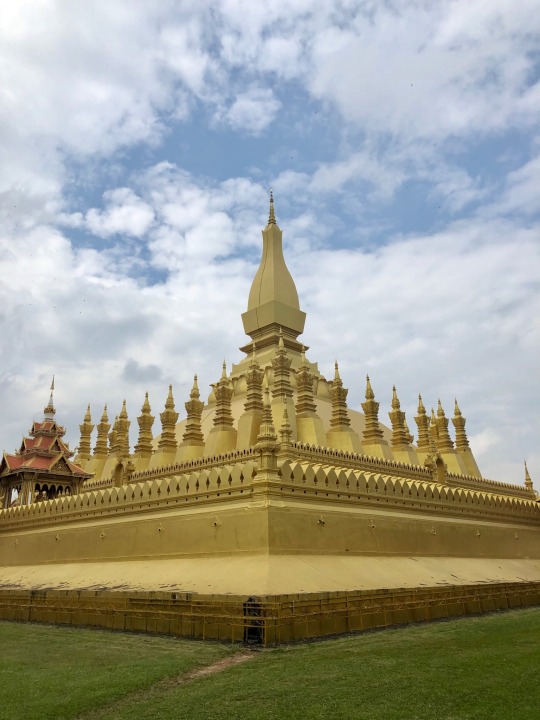
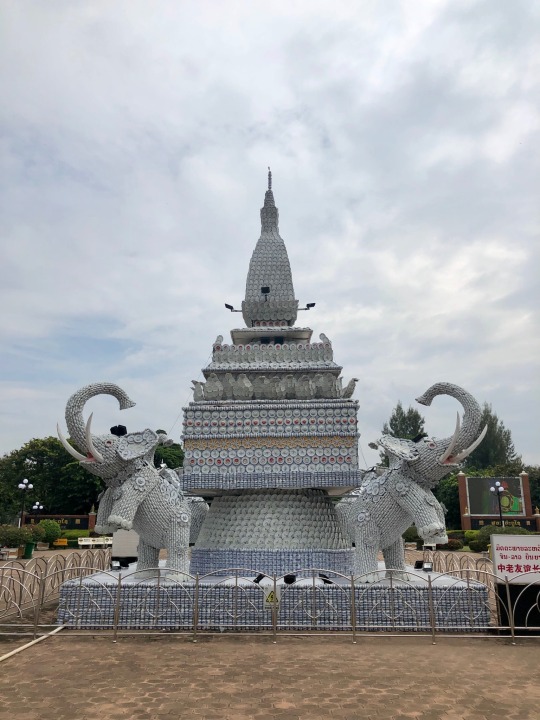
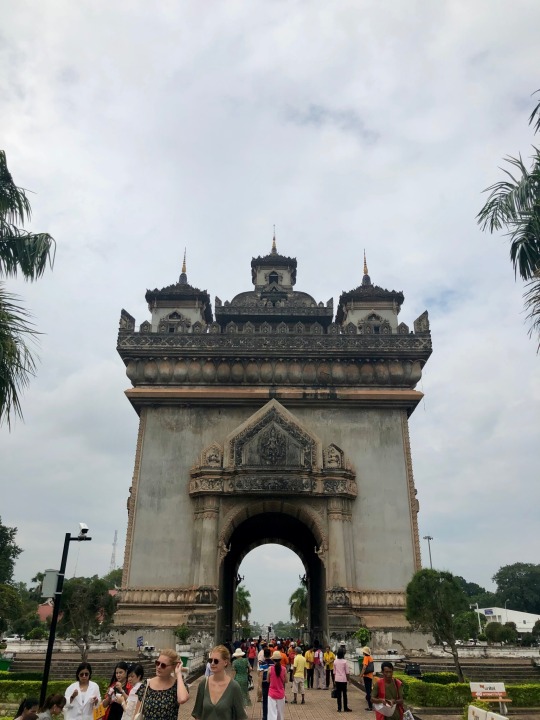

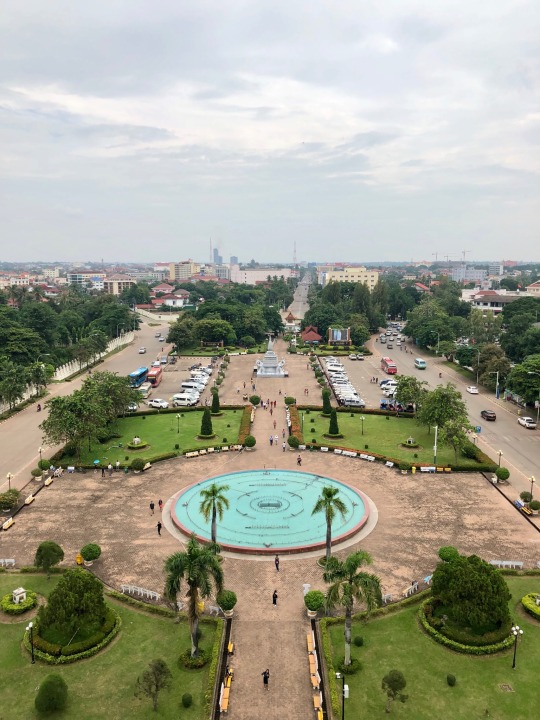
After a short rest in the room, decided to pay the mall next to the hotel a visit for lunch. There was the food court up top, but loads of them had pork and didn’t look exactly appetising. Had some fries and went down to have a look at what restaurants were around and stumbled upon Cafe Mango where they had the mango snowflake! But it was literally mango and shaved ice. Like nothing else. No syrup, no nata de coco, no nothing. Hah. Fortunately, it was still tasty.
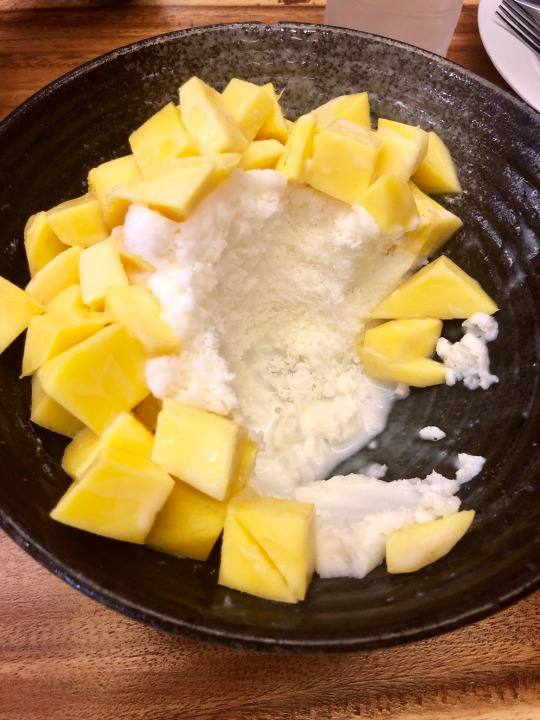
Had that, and headed back to the hotel to get some nap in. Hope you are enjoying your time with your friend, Z. Wishing I had your company through all of this.
Would’ve been a dream, sweetheart.
Goodnight, Z.
With Love,
A.
0 notes
Text
What you should know about politics but don’t
A non partisan take on issues
VOTING
- Hanging chad and how all machines are controversial voting systems
- Gerrymandering set after a census every 4 years
- Generally incumbents are voted in until they die? How again?
- Campaign funding is controlled by large organizations technically not associated but largely supported by the candidate
ECONOMY
- Great Recession bail out and why it was necessary, as well as the Dodd-Frank laws to constrain proprietary trading
- Taxes and how the rich are taxed at higher rates, while supply-side and trickle down Reaganomics believe tax cuts for the rich stimulate the economy with investments from the rich (largely not true), and types of taxes like income, capital gain, death tax and sales tax, some of which is double taxation
- Deficit and why it’s especially unfair to young people, why we have to keep China, Japan, Brazil, and Britain happy, and why whoever in power says deficit is ok, how Germany lent to Greek and fell due to the banking crisis in the US, and how deficit means higher interest rates for everyone
- Oil and how selling oil in Euros spiked the price for Americans, and how Russia and Iran approach oil differently
FOREIGN POLICY
- Opinions of war policy range from passive to active: liberal internationalists (diplomacy first), paleocons (weak today but at the time willing to fight in strategic situations), realists, liberal hawks, and neocons (super aggressive)
- Difference in realist and neocons are their motivation for security vs ideology. Liberal hawks are somewhere in the middle
- Middle East is a mess with the US invading Iraq for preemptive reasons when Bin Laden was in Afghanistan and then Pakistan
- Iran also has power with nuclear power and is clearly anti American
- Arab Springs led to the downfall of many governments, including an especially gory revolution in Syria
- Russia: oil, India and China: economic powers, and North Korea: built nuclear bombs without US consent
MILITARY
- military contractors: are they a good thing or is it dangerous to give power to wealth, connect private companies with government? Needed bc military is made up of volunteers but bad given they answer to no one
- don’t ask don’t tell: should we have repealed or were we merely protecting gays?
- drones: are they ethical? Or do we risk violating rights and killing civilians?
HEALTHCARE
- Universal access
- Healthcare is too expensive
- HMOs
ENERGY
- Coal is big in the US and though it is dirty it powers most of our electricity — most politicians are ok with it
- Electricity prices are controversial, as the FERC does not cap wholesale prices, leading to the great heatwave in 2000 in CA
- Oil is controversial bc the suppliers are Russia, Iran, Iraq, and Saudi. OPEC controls prices, and we are shifting towards Canada. Countries like Iraq have invaded Kuwait for oil, and some say the US Iraq war is for the same thing. The risk for the US all depends on when the Hubbert peak occurs
- Nuclear power is risky but most of France runs on it, due to what happens when it leaks
- Democrats want alternative energy and efficiency (CAFE sets average mpg rules for cars) and Republicans want more of what we have
ENVIRONMENT
- acid rain: spent billions to reduce acid rain being caused by coal burning
- ozone hole: easily reduced because had technology to replace it
- both Republicans and Democrats generally believe environment is a problem; started EPA with Republicans through Teddy
- aesthetics >> public health
- environmental moralists, utilitarians, deregulators
- Kyoto Accords cancelled eventually in 2009, but the US didn’t sign it; developing markets didn’t need to reduce
- Cap-and-trade market vs carbon dioxide tax, both strategies to reduce energy and adopted in the US in small ways
- renewable energy vs. Alaska for more oil: wind (disrupts nearby habitats), biofuel (needs a lot of land), solar panels (expensive and requires sun), hydrogen (need electricity to power)
CIVIL LIBERTIES
- philosophical inconsistencies between libertarians and executivists, along party lines
- free speech - Vietnam War and Occupy Wall Street led to questionable police behavior towards peaceful protestors, as well as obstruction of press
- gun violence - Brady Gun Law, urban and rural split
- Warrants and wiretapping - controversial during Bush era of PATRIOT ACT, but it helped prevent a lot of attacks, lenient post wiretapping approval
- Torture - rendition to other countries that will torture or move to offshore places helps get past US habeas corpus, which Obama didn’t really back down on, leaves the US in morale low ground
- Declaring war - similar lenient Congress support but presidents usually ignore this, saying only large world wars need congressional approval
- Capital punishment - is this cruel and unusual? Varies by state
CULTURE WARS
- Abortion: Rode vs Wade, not consistent by state
- Right to Die: Republicans support Terri’s Law to prevent state sanctioned murder, physician-assisted Suicide
- Stem cell research: not super political but Republicans don’t believe in it as much due to Bush’s restrictions that Obama incrementally lifted
- Gay marriage - prop 8 in California in 2008 legalizing gay marriage supported by Mormons
- Pledge of Allegiance, Ten Commandments - allow people to not say it, not put it on public facilities
- Mostly people don’t care about culture wars any way these days, except for the Christian Right
SOCIOECONOMIC POLICY
- Immigration: while everyone agrees illegal immigrants should not be here and that immigration should be controlled in numbers for practical reasons, we cannot figure out ways to deal with illegal immigrants already in the US
— Allowing drivers licenses to immigrants allows for better tracking of them but leads to risks like illegal voting, etc.
— Immigrants kept prices for low income work low as they increased supply with increased demand
— Deporting parents leads to higher costs for the children
- unions are supported by democrats in theory and criticized by republicans for taking jobs overseas
- social security - argue for privatization because government always loans from it, helps the poor or financially illiterate bc there is a cap on how much you get annually, and it is always projected for bankruptcy
- unemployment subsidies and the costs of hiring a woman
- agriculture subsidies - food wonks, food protectionists, and food free marketers; almost everyone supports it; it is needed to compete for markets in Europe that will pay more for food and to bring together dispersed interests
- food stamps and welfare - in the past food stamps were sold to buy drugs but has been fixed with electronic swipe system; today still mostly Democrats support stamps only, believing it is a private matter to support people;
- welfare was important in the Great Depression but became a dependency to be reduced; many poor immigrants work harder and better than the poor; culture is the root cause
HOMELAND SECURITY
- Pork infrastructure jobs get hired through ricision or earmarking, eg bridge to nowhere, and generally politicians support infrastructure for whatever region they represent
- Republicans usually favor privatization of roads, transportation. However Amtrak and private airlines are both examples of how this fails
- roads remain heavily subsidized with tolls or taxes (people prefer tolls on the turnpikes)
- Department of homeland security started after 9/11 by Republicans — doesn’t receive federal employee benefits of non-firing
- Infrastructure is failing, e.g. 2007 bridge collapse in Minneapolis
- Disaster response from FEMA is terrible, demonstrated by Katrina. However more of that could have been a wealth issue
EDUCATION
- has always been connected to race and class, with Republicans favoring freedom and Democrats favoring improvements to public schools
- busing, desegregation of schools in 1950s
- affirmative action quotas were outlawed but a middle ground was allowed as long as individual consideration still happened
- vouchers for private school is controversial given 70% or private schools are religion
- NCLB by Bush failed 50% of schools and was lifted by Obama, not providing support to failing schools — compassionate conservatism or just support McGraw for its political funding
TRADE
- protectionist (Democrats) vs liberalist or free traders
- Great Depression was the start of the trade wars of tarifs for all foreign imports, with protectionism generally looked down upon
- bureaucratic tariffs like more checks etc also exist
- After WW2, created:
—- World Bank to loan money to European banks suffering
—- WTO to regulate trade and provide IP protection
—- IMF to provide cash when a country goes bankrupt
- from this emerged the free traders, who believe developing worlds should not have free trade or protectionism pushed onto them
- free traders believe in morality issues and protectionists believe it hurts the US:
—- lose jobs to people overseas
—- pollution in China makes its way here
—- lack of labor standards abroad is immoral
—- corporations getting around taxes with overseas taxes
—- trader deficit since US imports more than it exports is a bad thing for the US
—- race to the bottom to compete within developing world for jobs from the US, hurting those in developing markets while the US affords more
- agreements like NAFTA pop up around the world: Arab, ASEAN, CAFTA, Malaysia and China, Russia and China, EC or parent of EU, with some challenging trade in the dollar
- banana war: forced EU to buy US Dole bananas thru sanctions and the WTO, angering the EU
- steel tariffs from GW Bush harmed auto industry buying steel in US
0 notes